Protect your data
This site uses cookies and related technologies for site operation, and analytics as described in our Privacy Policy . You may choose to consent to our use of these technologies, reject non-essential technologies, or further manage your preferences.
- Resume and Cover Letter
- How to Address a Cover Letter...

How to Address a Cover Letter to Recruiter or Hiring Manager
5 min read · Updated on November 24, 2021

Knowing how to effectively address a cover letter makes you a very visible and appealing candidate.
Did you know that the cardinal rule of cover letters is personalization? It impresses a hiring manager or recruiter because it tells them you took time to research the specific information for the letter rather than sending a generic version.
What many people forget, however, is that the greeting or salutation in a cover letter must also be personalized with the hiring professional's first and last name whenever possible.
There are several effective ways to find the hiring manager's name for your greeting — and some acceptable back-up strategies when you can't. Either way, knowing how to address a cover letter effectively can prevent you from ending your hiring chances before they even begin.
When you know the hiring manager's name
More often than not, you'll be given the name of the hiring professional or the manager that you'll work for. Whoever it is, use their full name (first and last name) in the greeting.
If you cannot definitively tell the gender of the hiring person, do not use a gender-based title such as “Mr.” or “Ms.” in the greeting. Instead just use the person's full name.
For example, Alex Johnson could be male or female. To avoid a gender mistake, use Dear Alex Johnson, Hello Alex Johnson, or simply Alex Johnson .
However, professional titles such as “Professor” or “Dr.” are definitely acceptable as a cover letter salutation and should be used as a sign of respect. Be on the lookout for these and other titles to include.
How to find a hiring manager's name for your cover letter
If you're not given the name of the hiring manager, here are some effective ways to discover their name by using:
The job description: Check this document for the hiring manager's name. While it's not generally listed, you never know. If it's not obvious, there's also a trick to quickly discover an email in the job description that might contain the name; while in the document, press Ctrl +F or run Command + F and search for the @ symbol.
An email address: If you discover an email address, it may not have a full name but rather a first initial and last name or just a first name like [email protected] or [email protected] . A Google search combining the person's name as shown in the email and the company name might find you the person's full name.
A LinkedIn post: A name connected to the LinkedIn job posting is probably that of the hiring professional who posted it, so use that name in your greeting.
The supervisor's title: It's more likely that a job description will list who the new hire will report to — such as the director of accounting — without listing a name. In this case, there are several search options:
Search the company's website for listings of staff members by title.
Run an advanced LinkedIn or Google search for all directors of accounting at that specific company.
Check with your network for someone who might know the person's name or search the appropriate professional networking sites.
Contact the company by phone or email. Tell them you're applying for [job title] and want to address your cover letter to the right person.
In the end, this research can be the difference between making a great first impression and getting noticed for the position — or getting totally ignored by the hiring manager.
Acceptable options in lieu of a name
If you try the steps above and come up empty, there are still some alternative greeting options that will put you in a professional light.
The idea is to show that you've read the job description and tailored your greeting based on the company department where the job is located, the hiring manager's title, or the team with which you'll potentially work.
Some good examples include:
Dear Head of Design
Hello IT Department
Dear Accounting Manager
To Company ABC Recruiter/Hiring Professional
Hello Marketing Hiring Team
Dear Customer Support Hiring Group
Dear Human Resources
If you still can't find any specific name or department information, go with “Dear Hiring Manager.” It sounds professional and it's not gender-specific. In fact, a recent survey of over 2000 companies by Saddleback College showed that 40 percent preferred “Dear Hiring Manager” as the best greeting when a manager's name can't be found.
“Dear Sir or Madam” is another option that works because it's gender-neutral and respectful. However, it sounds a bit old-fashioned and may signal a hiring professional that you're an older worker or just not aware of other greeting options. It's perfectly acceptable, but the better choice is “Dear Hiring Manager.”
In the end, an actual name or any of the alternative examples will let you stand out from the crowd, so do your best to find and use those whenever you can.
Never leave the greeting blank
Whatever information you may or may not find, it's important to never leave your greeting line blank.
A blank greeting line can make you come across as lazy or rude, or imply that you simply don't understand how to write a cover letter — all of which will immediately put you out of contention for the job. There's no reason to leave the greeting blank when there are so many options that can be used effectively.
When you spend the time and effort to personalize your cover letter, you don't want to come across as “just another candidate” by using a generic greeting or no greeting at all.
A personalized greeting will impress any hiring professional, increasing the chance they'll read your entire cover letter — and ask you for an interview.
Not sure if your cover letter is cutting it? Our writers don't just help you with your resume .
Recommended Reading:
Do Hiring Managers Actually Read Cover Letters?
5 Things to Say in Your Cover Letter If You Want to Get the Job
How To Write a Cover Letter (With Example)
Related Articles:
How to Create a Resume With No Education
From Bland to Beautiful: How We Made This Professional's Resume Shine
See how your resume stacks up.
Career Advice Newsletter
Our experts gather the best career & resume tips weekly. Delivered weekly, always free.
Thanks! Career advice is on its way.
Share this article:
Let's stay in touch.
Subscribe today to get job tips and career advice that will come in handy.
Your information is secure. Please read our privacy policy for more information.
To Whom it May Concern? How to Address and End a Cover Letter
We’ve put together a few tips to help you personalize your cover letter, whether you know the hiring manager’s name or not.
Customers Interviewed by:
In our modern age of personalization, To Whom It May Concern is both an antiquated and detached way to address a cover letter . It may also imply that you haven’t researched the company or that you assume the letter can be read by anyone. Below, we’ve put together a few tips to help you personalize your cover letter , whether you know the hiring manager’s name or not.
When it comes to addressing a cover letter, advice columns frequently spotlight these two pitfalls:
- Mistake 1 : Failing to address your cover letter to a specific person
- Mistake 2 : Addressing a cover letter to the wrong person
Most job postings don’t specify who will be reading your cover letter. This puts job seekers in a tricky situation. Fixing the first mistake could cause you to make the second. So what’s the best way to replace “To Whom It May Concern” on your cover letter?
Get instant feedback on your cover letter with Jobscan’s cover letter optimization tool. See it in action .
3 Key Tips for Addressing Your Cover Letter
1) don’t address your cover letter to the recruiter.
For many job openings, the first person you need to impress is a corporate recruiter. That doesn’t mean you should address your cover letter to them.
“Recruiters do not read cover letters,” a long-time healthcare recruiter told Jobscan . “Bottom line.”
That might be an overstatement — most don’t, some do — but many recruiters would admit that they aren’t the intended audience of a cover letter. “It’s mostly for the hiring manager,” said a recruiter in the non-profit industry. “For us [recruiters], it’s just an extra step in an already elongated process.”
The healthcare recruiter agreed: “If you’re sending it straight to a hiring manager who’s looking at a much lower number of applicants, they might actually read that.”
2) Search for the Hiring Manager’s Name
The best way to personalize your cover letter is to address the hiring manager by name. However, it can be difficult to identify the hiring manager, and your educated guess could cause you to address your cover letter to the wrong person. Here are some tips for finding the hiring manager.
Search the Company Website
Few job postings list the hiring manager by name but many will tell you the position to which you’d be reporting.
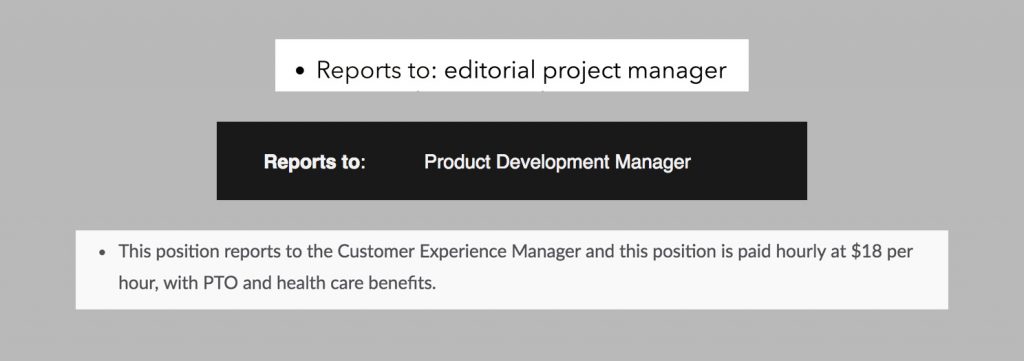
With this information, a little detective work can reveal the name of the hiring manager.
Start off by browsing the company’s website. Look for an about page, company directory, or contact page. These pages are frequently linked at the very bottom of the website. Companies that feature employees on their about page make it much easier to figure out who will be reading your cover letter.

You can also try searching the website. If the website doesn’t have a built-in search bar, use this syntax in Google:
“[position you’ll be reporting to]” site:company website

This will reveal hard-to-find about pages or other mentions of the position in the company’s blog posts, press releases, and other pages.
Search LinkedIn
If a company doesn’t list the hiring manager on their website, LinkedIn is your next best resource.
Start off by searching for the company page on LinkedIn. Once you’re on the company’s LinkedIn page, click “See all X employees on LinkedIn” near the top.

Depending on the company size, you can either browse all positions or narrow your results by adding search terms to the search bar (e.g. “Marketing Manager”) and utilizing the “Current companies” filters on the right side of the screen.
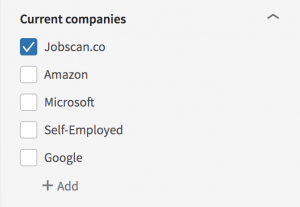
Search for the “reports to” position from the job listing. If it wasn’t provided in the listing, search for keywords related to your prospective department (e.g. “marketing”). If the company uses an intuitive corporate hierarchy you should be able to determine who will be reading the cover letter.
Contact the Company Directly
There is nothing wrong with calling or emailing the company to ask for the name of the hiring manager. Be polite and honest with the administrative assistant or customer service representative. Explain that you’re about to apply for a job and you’d like to know who you should address in your cover letter.
If they aren’t able to provide an answer or transfer you to someone who knows, let it go. The last thing you need is word getting back to the hiring manager that you were pushy with one of their colleagues.
3) Use a More Personalized “To Whom it May Concern” Alternative
You can still personalize your cover letter, even when you don’t know the identity of the hiring manager. Instead of “To Whom It May Concern,” which casts a wide net and is specific to no one, try addressing your cover letter to one specific person.
The most generic version of this is:
Dear Hiring Manager,
But job seekers can often be more specific. Take a look at these examples:
Dear Customer Experience Manager,
Dear Customer Experience Hiring Team Manager,
Some other alternatives include addressing your cover letter to an entire department:
- Dear Engineering Department,
Dear Engineering Team,
OR addressing the entire team:
Hi Jobscan Team,
Dear Jobscan Team,
As with many aspects of the job application process, demonstrating that you put in some extra effort can make a difference. Doing some research before addressing a cover letter contributes to a positive first impression.
8 cover letter salutation examples
Here are eight standard cover letter openings you can choose from. Select the one that best suits the energy of the company you’re applying to and use either a specific name or department depending on the information you have available.
- Hi Mr. Smith,
- Hello Jobscan Team,
- Dear Ms. Whittaker and Team,
- Good morning, Mr. Kennedy
- Good afternoon, Louise,
- To the Jobscan hiring manager,
How to end a cover letter
Just as important as beginning your cover letter is ensuring you end it on a strong note. Your cover letter ending should not be underestimated in its ability to help you move forward in the hiring process. After making your case in the previous paragraphs, you need to end your cover letter with a strong call to action to entice the recruiter to invite you for a job interview.
Madeline Mann , an HR leader in the technology industry and creator of Self Made Millennial , says that while no conclusion will save a bad cover letter, it can distinguish you from another good candidate.
It’s all about enthusiasm, according to Madeline. “Companies want people who want them,” she says. If you can draw to the company’s values and show how interested in working with them you are, that’s a substantial advantage. You want to create a lasting impression by incorporating that enthusiasm in your cover letter ending.
“Companies want people who want them” – Madeline mann
A good conclusion, in fact, should reflect the rest of your cover letter.
Set up the end of your cover letter with a strategic middle section
If you want your cover letter ending to be effective, you first need to build momentum. Most recruiters and career coaches agree that by the time you get to the end of your cover letter, it needs to possess the following three elements:
- It tells a story about yourself
- It shows your value concretely
- It calls the recruiter to action
Julia Reiter, a career coach based in Toronto, suggests that you lead up to your cover letter ending by showing that you understand the company’s current challenges and are equipped to solve them. This will make your cover letter call to action all the more effective.
Although the job description will give you information about what the company is looking to accomplish, it will not help you distinguish yourself from other applicants. Show the company you are willing to go the extra mile by researching the key industry challenges and the particular issues they might be facing (beyond the obvious ones).
For example, you can read articles from industry-related publications and get acquainted with the numbers and statistics about the particular business areas your company is engaged in. By being aware of the particular issues they are facing, you can more easily make your skillset and experiences relevant.
When you talk about your past experiences and accomplishments , make sure you mention the problems the company is facing. For example, if you are applying for a customer success manager position at a Software-as-a-Service company, a relevant issue might be high churn rates.
Instead of writing something like “my experience in customer success makes me confident I will be a great addition to your team,” write something like “When I worked at XYZ company, I was able to reduce the churn rate by 30%. With this experience and my deep knowledge of B2B consumer psychology, I am prepared to ensure we have one of the lowest churn rates in XYZ industry.”
End your letter with a call to action
You may be tempted to write that “I’m looking forward to hearing from you” for your cover letter ending. That isn’t a call to action. For Madeline, the end of a cover letter serves to give one last push and show interest and enthusiasm in a way that stands out.
Likewise, Julia says, “now that the company knows you are aware of their current challenges and are equipped to solve those challenges for them, don’t leave them hanging. Tell them how they can make your skills and experiences a reality on their team. What number can they reach you at for an interview?”
How do you conclude a cover letter? Here are 3 examples
- “I’m excited to have the opportunity to talk about how I could join your team in its quest for XYZ value. I’m particularly thrilled about XYZ project and would love to know how I can contribute to it.
- “I am keen on meeting with you to see what I can contribute to XYZ company as it moves on in its journey to XYZ goal. I am available at your convenience for a phone call or in-person meeting.”
- “I would love to get your thoughts on what I mentioned. I am happy to hop on a phone call at your earliest convenience to discuss how I can help XYZ company with XYZ issue.”
Read more : Check out our cover letter examples page, which covers a wide range of jobs, industries, and situations.
Mistakes to avoid when ending a cover letter
The mistakes people make when they end their cover letter are often the same ones they made earlier in the piece. However, they can be particularly detrimental to your chances of landing an interview if they constitute the final impression a recruiter has of you.
When ending a cover letter, avoid:
Making it about yourself instead of the company: use sentence constructions that make the recruiter see how the company is going to benefit from hiring you. For example, try to use “you” or “we” instead of “I.”
Sounding generic or robotic: we’ve all seen these cover letters that end with the same plain paragraph. If you write one of those, the last impression you’re giving is not different from those given by all other applicants.
Selling yourself short: the conclusion is your last chance to show off the value you can bring to the company. Emphasize it and use it as a segue into your call to action.
How to end a cover letter with the appropriate salutations
Always remember that recruiters review hundreds of applications for each position. When you are competing with that many candidates, the slightest mistake will disqualify you immediately Although you may not think too much of the salutations, they can hurt your chance of landing an interview.
Make sure your salutations are formal and polite. You should be respectful not only by indicating your appreciation of the recruiter’s time but also by being concise. Do not overdo your salutations and do not employ informal greetings. “Sincerely,” “Thank you for your consideration,” “kind regards,” are all safe options.
When ending your cover letter, you want to balance confidence, respect, and appreciation.
17 cover letter ending examples
Depending on the energy of the business you are applying to, and your own personality, select one of the following 17 cover letter closing options.
- Best wishes,
- Sincere thanks,
- Many thanks,
- Thanks in advance,
- Thank you for your consideration,
- Thank you for your time,
- Respectfully,
- Sincerely,
- Sincerely yours,
- Yours truly,
- Kind regards,
- With best regards,
- Looking forward to speaking with you,
- With gratitude,
One Final Important note: Cover letters aren’t what they say they are
Cover letters don’t introduce your resume, they supplement it.
In order to get your cover letter into the hands of a hiring manager who cares, your resume has to get past the recruiter and, in many cases, the applicant tracking system they’re using.
Try analyzing your resume below to receive instant optimization tips and recruiter insights from Jobscan so that the time you spend crafting your cover letter isn’t a waste.
The keyword analysis also shows exactly what to focus on in your cover letter.
Jobscan Premium (one month free) even has a cover letter scan feature.
Editor’s Note: A section of this article was originally written in a separate blog post by Léandre Larouche on June 9, 2020. It has been updated and combined with this article as of June 10, 2021.

Related Articles

June 21, 2024

June 20, 2024

June 18, 2024

June 17, 2024

June 12, 2024

June 11, 2024

June 4, 2024
Join 2 million job seekers who get bi-weekly job search tips
Get insider knowledge and ready-to-use job-seeking tips and hacks delivered to your inbox.
- Search Search Please fill out this field.
- Career Planning
- Finding a Job
- Cover Letters
How to Address a Cover Letter With Examples
:max_bytes(150000):strip_icc():format(webp)/ADHeadshot-Cropped-b80e40469d5b4852a68f94ad69d6e8bd.jpg)
Options for Addressing a Cover Letter
- Letter Without a Contact Person
- Non-Gender-Specific Names
What Title to Use
- Address an Email Cover Letter
- Review a Sample Cover Letter
Before You Send Your Letter
One of the trickiest parts of writing a cover letter comes at the very beginning. Much of the time, you won’t know exactly who will read your letter. How do you address your cover letter when you don’t have the contact person’s name and/or gender ?
First of all, try to find out the name of the contact person. Some employers will think poorly of an applicant who does not take the time to learn the hiring manager’s name. Also, take care not to assume that you know the gender of the recipient based on the name. Many names are gender-neutral, and some hiring managers may identify as a gender other than male or female.
It’s also possible that you’ll do your research and still be unable to figure out to whom you are addressing your letter. In that case, it's better to be safe and use a generic greeting . It's also acceptable to start a letter without a greeting and start with the first paragraph of your letter .
You have a lot of options when addressing your letter. Learn more about the possibilities before you make your choice.
How to Address a Cover Letter Without a Contact Person
There are a variety of general cover letter salutations you can use to address your letter. These general cover letter salutations do not require you to know the name of the hiring manager.
In a survey of more than 2,000 companies, Saddleback College found that employers preferred the following greetings:
- Dear Sir/Madam (27%)
- To Whom It May Concern (17%)
- Dear Human Resources Director (6%)
- Leave it blank (8%)
Do keep in mind that terms like "To Whom It May Concern" may seem dated, so the best options may be either to use "Dear Hiring Manager" or not to include a greeting at all. Simply start with the first paragraph of your letter.
How to Address a Cover Letter for a Non-Gender-Specific Name
If you do have a name but aren't sure of the person's gender, one option is to include both the first name and the last name in your salutation, without a title that reveals gender:
- Dear Sydney Doe
- Dear Taylor Smith
- Dear Jamie Brown
With these types of gender-ambiguous names, LinkedIn can be a helpful resource. Since many people include a photo with their profile, a simple search of the person's name and company within LinkedIn could potentially turn up the contact's photograph.
Again, you can also check the company website or call the company’s administrative assistant to get more information as well.
Even if you know the name and gender of the person to whom you are writing, think carefully about what title you will use in your salutation.
For example, if the person is a doctor or holds a Ph.D., you might want to address your letter to “Dr. Lastname” rather than “Ms. Lastname” or “Mr. Lastname.” Other titles might be “Prof.,” “Rev.,” or “Sgt.,” among others.
When you address a letter to a female employer, use the title “Ms.” unless you know for certain that she prefers another title (such as “Miss” or “Mrs.”).
“Ms.” is a general title that does not denote marital status, so it works for any female employer.
How to Address an Email Cover Letter
Hiring managers get a lot of emails each day. Make it easy for them to scan your email and follow up by including a clear subject line and a signature with your contact information. It's important to address the email cover letter correctly, including the name of the person hiring for the position if you have a contact, to ensure that your letter gets noticed.
Subject Line of Email Message
Never leave the subject line blank. There is a good chance that if a hiring manager receives an email with no subject line, they’ll delete it without even bothering to open it, or it could end up in their spam mailbox. Instead, write a clear subject indicating your intentions.
List the job you are applying for in the subject line of your email message , so the employer knows what job you are interested in. They may be hiring for multiple positions, and you will want them to identify the position you’re interested in easily.
How to Address the Contact Person
There are a variety of cover letter salutations you can use to address your email message. If you have a contact person at the company, address the letter to Ms. or Mr. Lastname. If you aren’t given a contact person, check to see if you can determine the email recipient's name .
If you can’t find a contact person at the company, you can either leave off the salutation from your cover letter and start with the first paragraph of your letter or use a general salutation .
How to Format the Salutation
Once you have chosen a salutation, follow it with a colon or comma, a space, and then start the first paragraph of your letter. For example:
Dear Hiring Manager:
First paragraph of the letter.
Body of Email Cover Letter
The body of your cover letter lets the employer know what position you are applying for, and why the employer should select you for an interview. This is where you'll sell yourself as a candidate. Review the job posting and include examples of your attributes that closely match the ones they are looking for.
When you're sending an email cover letter , it's important to follow the employer's instructions on how to submit your cover letter and resume.
Make sure that your email cover letters are as well-written as any other documents you send.
If you have attached your resume, mention this as part of your conclusion. Then finish your cover letter by thanking the employer for considering you for the position. Include information on how you will follow up. Include a closing, then list your name and your email signature .
Your email signature should include your name, full address, phone number, email address, and LinkedIn Profile URL (if you have one) so it is easy for hiring managers to get in touch.
Firstname Lastname Street Address (optional) City, State Zip Code Email Phone LinkedIn
Sample Cover Letter
This is a cover letter example. Download the cover letter template (compatible with Google Docs and Word Online) or see below for more examples.
Sample Cover Letter (Text Version)
Mary Garcia 12 Rogers Avenue Townville, New Hampshire 03060 555-555-5555 mary.garcia@email.com
February 17, 2021
Franklin Lee
CBI Industries 39 Main Street Townville, New Hampshire 03060
Dear Mr. Lee:
I was excited to see your ad for the operations assistant position in your Townville offices.
I have five years of experience as an operations assistant/associate. In my most recent role at ABC Corp., I fulfilled orders, resolved customer issues, ordered supplies, and prepared reports. In previous roles, I’ve done bookkeeping, data entry, and sales support. Basically, anything your department needs to run smoothly, I can do – and most likely, I already have experience doing it.
My other skills include:
- Strong communication skills, in person, in writing, and on the phone
- Excellent attention to detail and organization skills
- Top-notch customer service
- Experience in the industry and passion for the product
- Adept at all the usual professional software, including Microsoft Office Suite
I’ve included my resume for your review. Please contact me if you have questions or would like to schedule an interview. Thank you for your consideration.
Signature (hard copy letter)
Mary Garcia
Review Cover Letter Samples: It’s hard to write cover letters from scratch. To make life easier – and to make sure you don’t forget any of those pesky formatting rules —start by reviewing cover letter samples . Sending an email version instead? Look at a few examples of email cover letters to get started.
Customize Your Cover Letter: Why personalize your cover letter every time you apply for a job? Because even similar job titles have different requirements. The goal of a cover letter is to show the hiring manager that you’re the best candidate for this particular job. Customizing your cover letter will help you emphasize your skills and experience and how they fit with the job requirements .
Spell-Check Names: Before sending your cover letter, make absolutely sure that you have spelled the hiring manager’s name correctly. That is the kind of small error that can cost you a job interview.
Carefully Proofread Your Letter: Whether you're sending an email or uploading or attaching a printable cover letter, it's important to make sure that your cover letter and resume are written as well as any other business correspondence. If you can, have a friend proofread before you hit send, to pick up any typos or grammatical errors.
Saddleback College. " Your Resume is Your 1st Interview ," Page 14. Accessed Feb. 17, 2021.
How to Write a Cover Letter to a Hiring Manager (With Templates)

Oh, the never-ending confusion and debate over cover letters.
Do I need one? Will anyone read it? How, exactly, can I make sure an actual hiring manager reads it?
Never mind the whole—and rather crucial— “what should my cover letter say?” piece of this equation. There’s so much to consider, it’s no wonder why people often under-use or forego the cover letter altogether when looking for a job.
I’ve long been in the “heck, yes” camp on cover letters. Let me explain why and share some essential tips on what to incorporate in your next cover letter if you want to grab the attention of a hiring manager and get them to call you for an interview.
Why should you write a cover letter?
I’d like to tell you not to worry about crafting a cover letter for the next role you pursue, but here’s the thing (and you’ve probably noticed it): Competition’s fierce in more than a few career fields right now. Given this, you’ll be wise to do everything you can to stack the odds of landing an interview in your favor.
This includes a cover letter. If a recruiter or hiring manager is on the fence about you as a viable candidate, a thoughtfully written cover letter might just nudge you into the “yes” pile.
So, for this reason alone, I’d make the time for it.
Now here’s the good news—most people squander the opportunity. They either opt out of writing a cover letter entirely or, nearly as bad, they submit bland, cliché-filled, or redundant-to-the-resume clunkers.
Given this, hiring managers and recruiters don’t expect to lay eyes on a cover letter that’s memorable, compelling, and on point. When they do? They take notice.
Essential tips for your next cover letter
So how do you pull off a winning cover letter, one that conveys your passion and talent and makes the recruiter or hiring manager’s day? Follow these steps:
1. Choose the right salutation
We are well past the days when “To Whom It May Concern” or “Dear Sir or Madam” were considered gold standard business salutations. Unless you’re hoping to look like a nonagenarian on paper, plan to address your cover letter directly to the hiring manager or recruiter involved with the search.
It may seem difficult to sleuth this out, but it’s often easier than you may think. Just mosey over to LinkedIn and do a People search using the company’s name as your search term. Scroll through the people working at that company until you find someone who appears to be the hiring manager. (Hint: the job description may tell you who the position reports to.) If you can’t find a logical manager, try locating an internal recruiter or, in smaller companies, the head of HR.
If you aren’t able to pinpoint this information, go with something more general but still personal and appropriate for current times, like “Dear Muse Marketing Team,” or “To the HR Business Partner Hiring Team.”
Read more: The 3 Rules of Addressing Your Cover Letter in 2023
2. Convey your interest and value
Decision makers never want to feel like you’re wallpapering the universe with the same cookie-cutter cover letter. They want to know you’re approaching their organization for specific reasons. Maybe you love their mission, their products, or their reputation as a great place to work.
Lead with this then, using the job description (and whatever other information you’ve gathered) as your guide, then outline what, specifically, you can walk through their doors and deliver. Make it clear as quickly as possible that you’ve got the goods.
Here's an example: “As a long-time cyclist, I know a thing or two about chafing. I also know that plenty of chamois creams just don’t do the trick. Yours does, and I’ve been a loyal fan and user for years. You’ve reduced friction for me and now I’d like to do the same for you as your next Customer Service Manager.
I’m [Name], a personable and solution-focused customer service professional who consistently ranks among the top 5% of performers at my current employer. Here’s what I can deliver in this role:”
And then expound on a few of the skills you bring to the table, with particular emphasis on the priority requirements for that role (they’re typically listed first on the job description or mentioned more than once).
3. Finish strong
You certainly don’t want to fizzle out at the finish line. In fact, if I had a dollar for every time I’ve read this exact sentence on a cover letter, I’d have a lot of dollars:
“Thank you for your consideration. I hope to hear from you soon.”
Instead, work to sum up why you’re a great candidate and welcome an opportunity to meet to discuss their needs and your qualifications further.
Here's an example: “I believe my collaborative work style, commitment to customer satisfaction, and strong belief in the value of your products will enable me to make considerable impact, quickly. I would love to learn more about your specific goals and needs and share details on how I may contribute. I hope to meet soon!”
And a last, critical tip when it comes to delivering a great cover letter to a hiring manager: Be you. Honest, genuine writing always goes much, much further than trying to emulate the tone and structure encouraged in outdated career guides and textbooks.
Rules can be bent. In fact, if you’re working to make a lasting impression and land that interview? Oftentimes, they should be.
How to Address a Cover Letter in 2024

Yes, how you address your cover letter matters.
After all, this is the first thing the recruiter reads when going through your cover letter, and yes, there is a right and wrong way to do it.
In this article, we’re going to teach you how to address your cover letter in such a way that you leave a positive impression on any recruiter!
- How to address a cover letter to a recruiter? (Casual or formal)
- What title to use when addressing the hiring manager
- How to address a cover letter without a contact person/to a company
- How to address a cover letter without an address
- How to address a cover letter in an email
How to Address a Cover Letter To a Recruiter (Casual or Formal)?
As we already mentioned, the way you address your cover letter is important because it is the very first thing recruiters see upon opening your cover letter.
A well-formulated cover letter address means that you care enough to research the company (i.e. to find the hiring manager’s name and title) and that you show attention to detail.
As such, you should always put some research into who you’re addressing your cover letter to and do so in a formal way.
And yes, the formal part is important too. The recruiter isn’t your best friend - you want to maintain a sense of professionalism.
If this is how you address the recruiter in your cover letter:
- What’s up Hiring Manager
- Hi there Hiring Team
Then you say goodbye to the job.
Now, you’re probably wondering, how can I find out whom to address my cover letter to?
That’s what we’re about to teach you:
Who Am I Addressing My Cover Letter To?
Here are some tricks to find the full name of the hiring manager:
- Check the job listing. The job listing may have information about the recruiter or the department doing the hiring. Make sure to read through the entire job listing, as it might not be at an entirely obvious place.
- Check the company website. Some websites feature the names of the hiring managers or heads of departments that may go through your cover letter. Alternatively, LinkedIn is another place where you can look for this information.
- Check the company’s LinkedIn. You can look up who works in the company you’re applying for on their LinkedIn page.
- Ask around. Do you have friends that work for the company? They could provide you with valuable inside info.
To avoid making a bad impression, head over to our guide on cover letter mistakes to learn about what NOT to do when writing your cover letter.

Addressing a Cover Letter With a Name
By now, you have probably found the hiring manager’s full name and gender. With this information available, it’s best to address the hiring manager formally, as follows:
- Dear Mr. Brown,
- Dear Miss Fitzpatrick,
- Dear Mrs. Lockhart,
- Dear Ms. Walters,
If, for some reason, you are unsure about the person’s title, gender, marital status, or preferred pronouns, just address them using their entire name to avoid any mistakes. For example:
- Dear Alex Brown,
- Dear Blair Fitzpatrick,
- Dear Jesse Lockhart,
- Dear Madison Walters,
Addressing someone with a title
Now, if you found out that the hiring manager has a professional or academic title, then it’s more appropriate to address them using that title. If, for example, the hiring manager has a Ph.D., then it’s more respectful to address them as “Dr. Last Name,” instead of “Mr. Last Name.”
Here are some professional titles and how they’re abbreviated:
- A professor is Prof.
- A reverend is Rev.
- A sergeant is Sgt.
- Honorable is Hon.
If, however, you are uncertain about how a title is abbreviated, then avoid it altogether.
Here are a few examples to give you an idea:
- Dear Prof. Welsch,
- Dear Director Smith,
- Dear Rev. Owen,
Dear Dr. Leonard,
When addressing women and you don’t know their marital status, always go with Ms., because it doesn’t comment on marital status. Some women prefer not to be addressed with Miss or Mrs. even when they’re married, so sticking with Ms. is the best choice.
Want to learn more cover letter tips ? Our guide has all you need to ace your cover letter!
How to Address a Cover Letter Without a Contact Person
It might happen that, no matter how hard you search, you can’t find the name of the hiring manager or department head that will read your cover letter.
In that case, you can address your cover letter to the department, faculty, or the company.
- Dear Software Development Hiring Team,
- Dear Customer Service Department Hiring Team,
- Dear Head of the Literature Faculty,
- Dear Director of Marketing,
- Dear Human Resources Recruitment Team,
Alternatively, if you don’t have enough information either about the department or the team, you can opt for addressing the cover letter directly to the company’s hiring staff, as follows:
Dear [Company Name] Hiring Team
Dear [Company Name] Recruiting Staff
If all else fails (meaning, you don’t know the name of the department head or even the exact department, in addition to the recruiter) then you can use one of the good, old-fashioned:
Dear Hiring Manager,
...but NOT the impersonal and way outdated “To whom it may concern” and “Dear Sir/Madam.”
Starting a cover letter can be challenging. Our guide can show you how to start a cover letter that will get you results from the get-go.
How to Format the Company’s Address
Before you reach the salutation, you have to make sure that the header with the recipient’s contact information is formatted correctly.
It might not be the deciding point of whether you’ll secure an interview or not, but it will cost you points if it’s off.
So, the first thing you want to do is add your name and surname on the upper left side of the cover letter. Underneath, you should write your professional title (if applicable), your email , and your phone number .
Now, after you’ve also added the date, you should leave one more space and add the recipient’s contact information and, most importantly, the company’s address.
It should look something like this on your cover letter:

When You Can’t Find the Company’s Address
Some companies might have several addresses listed (as per their branches, for example), or even none at all.
Since an application that doesn’t have an address line could end up lost or misplaced, make sure you do one of the following before skipping the company’s address completely:
- Check all your resources, (pretty much like when you were looking for the hiring manager’s name) to find the company’s address.
- Use the company’s headquarter address. This is sometimes easier to find, especially if the company has several branches.
- Use the P.O. Box number for the company. This is not as specific as an actual address line, but if all else fails, it’s still something.
Frequently, you’ll be asked to submit your job application (including your cover letter) electronically, or by email. In those cases, you can skip the address line altogether.
Here’s how you’d go about addressing a cover letter in an email.
How to Address an Email Cover Letter
If you’re sending your job application through email, chances are you’ll need to format your cover letter in the body of the email, or as an attachment along with your resume.
First and foremost when you’re addressing a cover letter in an email is the subject line, which should be between 6-10 words long.
Considering that hiring managers receive countless emails daily, you want to make sure that yours is a job application immediately. And the way to do that is straight through the subject line, which should indicate exactly the position you’re applying for and your name so that it’s easier to find through the recruiter’s swarmed mailbox.
Here’ what we mean by that:
- Subject Line: John Doe - Software Development Job Application
- Subject Line: John Doe - Job Application for Marketing Manager Position
- Subject Line: John Doe - Stock Manager Job Application
Afterward, if you’re including your cover letter in the body of the email (as opposed to attaching it as a document), begin by using a salutation, add space, and start your letter.
If someone referred you for the position, make sure to mention that in the subject line of your email as well as in your opening paragraph.
So, let’s see how all the above plays out in practice:
Subject Line: John Doe - Carl Jacob’s Referral for Software Developer
I was very glad that Mr. Jacobs, a long-time partner at your firm who also happens to be my mentor from college, referred me for the Software Developer position.
Do you want your style, personality, and overall personal brand to shine through your application? With Novorésumé, you can match your cover letter with your resume to make a lasting impression!

Key Takeaways
And that’s all there is when it comes to addressing a cover letter! You should feel much more confident in doing so by now.
Either way, let’s go over the main points we covered throughout the article:
- Your cover letter address should be formal and well-researched. Don’t address the hiring manager with “hey,” “what’s up,” “hi there,” or even the old-fashioned “Dear Sir/Madam” and “To Whom It May Concern.”
- Always try to find the hiring manager’s full name and professional title through the company’s website, LinkedIn, by calling, or by asking someone who works there.
- If you know the hiring manager’s name, go with “Dear Mr./Miss Last Name,” but if you’re unsure about their gender, marital status, or preferred pronoun, just address them using their full name.
- If the recruiter has a professional or academic title, it’s more appropriate to address them using their title.
- If you can’t find the contact person’s name, then address the department, faculty, or company (i.e. Dear Microsoft Hiring Team , or Dear Software Development Recruitment Team ).
Related Readings:
- Do I Need a Cover Letter in 2024
- Entry-Level Cover Letter
- Cover Letter for Internship
- How to Write a Cover Letter in 2024

To provide a safer experience, the best content and great communication, we use cookies. Learn how we use them for non-authenticated users.
- Knowledge Base
- Free Resume Templates
- Resume Builder
- Resume Examples
- Free Resume Review
How to address a cover letter?
I'm sure that you had to create a cover letter at some point in your job search. And like most other job seekers, you probably came across this problem: "How to address a cover letter?"
Most of the time, you have no idea who is going to read the cover letter.
So, how to address a cover letter without a name?
Hiring managers get roughly 100-200 resumes every day. And, they are already under a lot of pressure to sort the resumes.
On top of that, if they get cover letters that do not have proper formatting and do not address the hiring manager in the cover letter header, mark my words; they will surely throw your resume away.
In a resume cover letter, minute details make or break your chance of being hired.
So, you need to make sure that you know how to address cover letter correctly.
Don't worry!
In this blog, we will tell you everything you need to know about:
- Who to address cover letter to?
- How to address a cover letter without a name?
- How to find out who to address a cover letter to?
- How to address an email cover letter?
- How to address a cover letter for internal position?
- What should you not do when addressing a cover letter?
- Example of Proper Cover letter address format?
- Some common question about how to address cover letter
Who to Address a Cover Letter To?
Ideally, you need to address your cover letter to hiring managers , not the recruiters .
In many job postings, the name or email address of the hiring manager is given.
If you are lucky enough to find such job listings, then you are sorted. You can write a personalized cover letter addressing the hiring manager directly.
Unfortunately, not many job listing sites give the name and email address of the contact person.
Do not quit and send the cover letter without a name.
Go to the company website/about page and see if it has the list of staff.
That way, you can probably get the hiring manager's name or someone from the talent acquisition department to whom you need to address your cover letter.
The critical aspect is to do a lot of research .
Suppose you still don't find any name or contact information of anyone in the hiring department. In that case, you can also address your cover letter to someone in authority in other departments, such as the senior manager or the head of the department you are applying for.
It is a hundred times better to address your cover letter to someone in the organization than not addressing it at all.
At least, this way, they will understand that you are not throwing rocks in the dark. You have done your research and have good ideas about the organization.
Also Read: How to write a stellar cover letter in 2022?
How to Address a Cover letter Without a Name?
There are plenty of generic cover letter salutations you can use in your cover letter. These generic cover letter salutations eliminate the need to know the name of the contact person.
The only drawback is that you have no option to personalize your cover letter.
A survey conducted by Saddleback College has seen that only 8% of hiring managers are ok with a cover letter without name. But 92% of hiring managers prefer to have some address in the cover letter.
- Dear Hiring Manager (40%)
- Dear Sir/Madam (27%)
- To Whom It May Concern (17%)
- Dear Human Resources Director (6%)
However, we don't recommend you to use to whom it may concern in your cover letter address.
Instead, the best general salutation can be "Dear Hiring Manager."
If you want to personalize the address, you can address your cover letter to the specific department you are applying for. For example, "Dear Digital Marketing Department."
How to Address Cover Letter When You Don't Know Hiring Manager's Gender?
There will be times when you will find the gender-neutral name of the hiring manager. In that case, altogether avoid using gender-specific cover letter addresses. Instead, address with their both name and last name in the salutation like this:
- Dear John Doe,
- Dear Charlie Brown ,
- Dear Taylor Paisley,
Hiration Pro Tip : In this type of gender-neutral name, you can search for the person on Linkedin to find out their gender. Alternatively, you can search on the company page or call the company reception to get more information about the hiring manager.
How to Address Cover Letter When You Know Hiring Manager's Gender?
If you know the hiring manager's gender, things will be much easier for you. For men, you can address the hiring manager with "Mr.," but things get a bit tricky for female hiring managers.
Imagine this,
You have addressed the hiring manager with "Miss.," and if she turns out to be married, it will not look good on your part. You definitely do not want to offend your hiring manager.
Instead of "Miss" or "Mrs.," use " Ms.," which does not focus on their marital status.
- Dear. Ms. Moore,
- Dear Miss Jane,
- Dear Mrs. Black,
Should You Address the Hiring Manager With Only Their First Name?
If you know the hiring manager personally, only then can you use their first name to address the cover letter. Else, address the letter with their full name.
How to Use Professional Titles When Addressing a Cover Letter?
If the hiring manager has a professional or academic title, don't forget to address them by their title. You can write the full title like this:
- "Dear Doctor Taylor,"
Or you can use the abbreviated form like this:
- Dear Dr. Taylor ,
- Dear Sgt. Park,
- Dear Prof. Hoverman,
- Dear Principal Fury,
Also Read: How long should a cover letter be?
How Do You Find Out Who to Address a Cover Letter To?
If you don't find the hiring manager's name and contact information on the job description, don't just leave it like that! Do some research and put some effort into finding the name and email id of the hiring manager.
It may take some extra effort, but it shows that you are interested in this job. This section will tell you everything you need to know about finding the hiring manager's name and to who you address a cover letter.
Call the Company
Calling the company to ask for a hiring manager's details is the best way to accurately determine the hiring manager's name and number.
- Call the company desk
- State who you are and why you are calling
- Tell that you are applying for a job position and confirm who the hiring manager is for addressing in the cover letter.
- Most of the time, the hiring manager will happily give you the information you need.
Tip : When taking their name, ask for the spelling of the hiring manager's name. You do not want to screw up the spelling.
If the company desk refuses to give information for any reason, don't worry; we have four other ways in our arsenal.
Network With People Working With Prospective Employer
The second best way to get the hiring manager's name and contact information is to connect with your prospective employer's employees.
This way, you can ask your connection to refer you to the hiring manager or ask for the hiring manager's contact information when a job becomes available.
It is easier than you think.
Just do a quick Linkedin search and see the employers active on Linkedin.
Now, slowly start engaging with the person you want to connect with.
After a couple of days, send them a personalized connection request and slowly build a rapport.
You do not want to ask right out for reference after introducing yourself. Instead, add some value to the conversation, and show genuine interest in them.
This process takes some time, but the connection you will make with these people will take you a long way in your professional journey.
Read the Job Description Carefully
It is a sad truth that most job seekers do not read the job description carefully. In this way, they miss vital information and potentially the hiring manager's contact name and details.
Most of the job descriptions contain the email address of the hiring manager at the end. And you can easily find the name of the contact person with the email address.
Most professional email ids contain the name of the person and the company name. For example, [email protected] has two parts- Judy.M and hiraiton.com.
And if you search on Google by the first part of the email address "Judy.M" and the company name, there is a high chance that you will find the Linkedin profile of the respective person. And you can get to know other information about them as well.
Find Out Who Will Become Your Superior or Manager
Many job descriptions include the details about the reporting manager. In such cases, you need to address your cover letter to the reporting manager.
You can find more information about the reporting manager by a quick Linkedin search with the reporting manager's job title and the company.
If the company is larger, there may be multiple individuals with the same job title. In that case, you can further narrow down your search by location.
Do an Online Search
Another easy way to search for the hiring manager is by simply doing a Google search. Google will show you the most relevant results for your search query. Example: See in this example how the first result itself answered your question.

Also Read: How to address a cover letter without name?
How to Address a Email Cover Letter?
We live in a digital age now.
Nowadays, most candidates send email cover letters to the hiring managers. And hiring managers get 100s of email cover letters daily.
To stand out from these 100s of email cover letters, you need to make sure your email cover address is perfect.
1. Subject Line of Email Cover Letter
The first thing the hiring manager will see is your email cover letter subject line. So, never leave the subject line blank.
Hiring managers sort the email cover letters by the job title. And if your cover letter does not have a subject line, it will not show in the hiring manager's list.
Here is an example cover letter subject line :
Subject line: Job Application for Video Editor Position, Ref: Hanna Moore
2. Address the Cover Letter in the Correct Way
The rules of a formal cover letter and an email cover letter salutation are similar. You can refer to the previous section of this blog to know more about it. Here is an example of an email cover letter address
- "Dear Mr. Doe,"
Note : Recent trends have seen many job seekers do not include "Dear" in the salutation. You can do that too. There is nothing wrong with it.
Also Read: How to start a cover letter for maximum impact?
How to Address a Cover Letter for Internal Position?
If you address the cover letter to higher management or hiring manager, always use their name to address in the cover letter.
luckily, since it's an internal position, you can easily find the name of the person by asking your colleagues.
What Not to Do When Addressing a Cover Letter
Even if you did everything right on your resume and cover letter, starting it wrong may cost you a chance to get a call for an interview.
Let's see what you should not do when addressing a cover letter.
Do Not Address the Cover Letter to the Recruiter
" Recruiters do not read cover letters. "
Recruiters only sort the resumes by keywords and forward the same to the hiring managers.
This is the golden rule you need to keep in mind when addressing a cover letter. Always address the cover letter to the hiring manager.
Do Not Address the Cover Letter to an Ex. Hiring Manager
Company websites do not get updated regularly. If a hiring manager leaves the company, you may still find their name and contact information on the website or other third-party websites. So, be extra careful when addressing a cover letter.
Spelling the Hiring Manager or Company Name Wrong
Do not sabotage your first impression by making a spelling mistake on the hiring manager's name or the company name. It demonstrates a lack of attention to detail.
Do Not Start With a Bland Greeting
Avoid using to whom it may concern cover letter address. It is very generic and shows utter laziness on your part. It projects that you did not put much effort into writing the cover letter.
Example of a Cover Letter Address Format
Here is an example of a proper cover letter address format:

Frequently Asked Questions
How to address a cover letter to a large company.
If you have to address a cover letter to a large company, and you don't know the hiring manager's name, you can always address the cover letter to the department you are applying job to. For example:
- Dear Finance Department
- Dear Marketing Team
- Dear Customer Service Department
Can I get creative with my cover letter address?
There is no restriction on being creative with addressing a cover letter. It is essential to research and understand who your audience is and if he/she will appreciate your creativity.
For example, if you do something creative with your cover letter salutation to apply in a creative field, it will get the hiring manager's attention.
On the other hand, if you apply for a technical position, you might hold off from showing your creativity on the cover letter address.
Should a cover letter address the company location?
It is a traditional practice to include the company address in the cover letter. Primary because it is a formal document, it would be better to add the company address before starting your cover letter.
Should a cover letter header include the candidate's address?
The candidate's address is an essential part of the cover letter. If not the whole address, at least City, Country should be mentioned in the cover letter. Example:
- "Pine Bluff, AR"
This helps the hiring manager sort the candidates based on location.
Also, the Application Tracking Softwares sort the resumes and cover letters based on their locations. And if your location is not mentioned in the cover letter, it might get unnoticed by the ATS software.
Should a cover letter header, and resume header be the same?
Ideally, your cover letter header should be the name of the role you are applying for. And resume heading should be your current job title. For example, if you are currently working as a data analyst, your Resume headline should be something like:
- "Jr. Data Analyst."
And you are applying for a Data Scientist position, then your cover letter heading should be,
- "Data Scientist"
There is no hard and fast rule, but this is the approach we at Hiration follow, and it has been working for our clients.
You can also write the same heading for the cover letter and resume if you like. It has some added advantages. If the cover letter gets misplaced, it will be a lot easier to trace it back to the resume.
How to write the intro to a cover letter?
If you want to hook the hiring manager to read your cover letter, you need to write a professional intro explaining why you are applying and what role you are applying for.
You need to remember that hiring managers are often dealing with recruitment for more than one position. And it will help them if you specifically mention what role you are applying for.
Key Takeaways
With that, we have come to the end of this blog. By now, you should get all of your questions answered. But still, if you have any questions regarding how to address a cover letter and who to address a cover letter, let's go over the key takeaways of the blog:
- Do not send the cover letter without addressing someone.
- If you do not know who to address, call the company desk or go to LinkedIn to search the hiring manager's name.
- If you do not know the name, you can address the cover letter with "Dear Hiring Manager,"
- Alternatively, you can address the cover letter to the head of the department you are applying for. For example: "Dear Sr. Marketing Manager,"
- Make sure to use accurate professional and academic titles with the name of hiring managers.
- Do not use "To whom it may concern." It is old-fashioned and does not impress the hiring manager nowadays.
Go to Hiration career platform which has 24/7 chat support and get professional assistance with all your job & career-related queries. You can also write to us at [email protected] and we will make sure to reach out to you as soon as possible.

Share this blog

Subscribe to Free Resume Writing Blog by Hiration
Get the latest posts delivered right to your inbox
Stay up to date! Get all the latest & greatest posts delivered straight to your inbox
Is Your Resume ATS Friendly To Get Shortlisted?
Upload your resume for a free expert review.

- Career Advice
- Cover Letters
How to Address a Cover Letter
The beginning of a cover letter typically includes a salutation to the person who will be reading it—most likely the hiring manager. This important first line, written in the proper format, makes a positive first impression and can help you land an interview with a potential employer.
Cover Letter Address Template
Download a free cover letter address template in MS Word format.
Cover Letter Address Template:
[Full Name]
[Email Address]
[Contact Number]
[LinkedIn Profile/website link]
[Name of the Company or Institution receiving your cover letter]
[Subject Line]
[Cover letter body.]
[Insert name]
A step-by-step guide to addressing a cover letter.
How to address the hiring manager.
Find the name of the hiring manager..
While it's important to address the hiring manager directly in your cover letter, oftentimes a job ad won't mention a contact person, especially if it's advertised through a recruiter. Fortunately, you can often find out who the hiring manager or head of the department is with a quick internet search. If all else fails, use "Dear Hiring Manager."
Address hiring managers by name if possible.
Always address the hiring manager directly by using Mr. or Ms. followed by their last name. Furthermore, using Ms. instead of Miss or Mrs. will avoid offending a female hiring manager, particularly if you don't know her marital status.
For example:
"Dear Mr. Smith"
"Dear Ms. Smith"
If you're unsure about the gender of the hiring manager, use both their first and last names.
"Dear Taylor Smith"
"Dear Jordan Newton"
Use the correct title.
Generally, using a professional title conveys respect and should always be used when the hiring manager has one, such as Doctor, Professor, Sergeant, Reverend, etc. You can shorten the title for brevity.
"Dear Dr. Smith"
"Dear Prof. Einstein"
"Dear Sgt. Newton"
"Dear Rev. Parker"
Address unknown hiring managers by their job title.
When you don't know the name of the hiring manager, the most acceptable salutation to use is "Dear Hiring Manager." Although you're not addressing someone directly, it still conveys professionalism and attention to detail. Avoid using the antiquated "To whom it may concern."
"Dear Customer Service Hiring Manager"
"Dear Sales Team Hiring Manager"
Note: Use a comma after your salutation, followed by a space and the body of your cover letter.
How to address an e-mail cover letter.
Include a subject line..
Hiring managers receive tons of emails so it's important to include a clear subject line indicating which job you are applying for.
Subject Line: Job application for sales manager position.
Address the hiring manager.
Start off the body of your email with the hiring manager's name or use a general salutation.
Dear Mr. Smith, OR Mr. Smith,
[Cover letter text...]
Include your name and contact details.
Lastly, sign off your email with your name, email address, phone number, and LinkedIn profile or website link.
Samantha Phillips
+09 012 029 9234
www.samanthaphillips.com
Common cover letter address mistakes:
- Make sure that you've addressed your cover letter to the right person, and that their name is spelled correctly.
- Do not use "Hello," "Hey," or "Hi," as this could come off as too informal.
- Do not use outdated salutations like "Dear Sir," "Dear Madam," or "To Whom it may Concern."
Additional Resources.
- Best Cover Letter Generators .
- Best Cover Letter Tips .
- Common Cover Letter Mistakes .
- Best Resume Builder .
- Skills to Put on a Resume .
- Best Font for Resume .
- How to Prepare for a Job Interview .
Common Cover Letter Mistakes
How do I address a cover letter?
Always address the hiring manager directly by name . If you don't know the hiring manager's name, do some research or use a general salutation.
How do I address a cover letter to a PHD (doctor)?
If the hiring manager has a professional title , always put the title in front of their name, e.g. "Dear Dr. Einstein."
How do I start a cover letter?
It's important to start a cover letter with a greeting or salutation .
What is a good cover letter address format?
Addressing the hiring manager by name shows professionalism and establishes a connection. If you don't know their name even after doing a Google search, use a general salutation like "Dear Hiring Manager."
How do you address a cover letter to an unknown recipient?
It's acceptable to use a general salutation like these:
- "Dear Hiring Manager."
- "Dear Sales Team Hiring Manager."
- "Dear Customer Service Hiring Manager."
- "Dear IT Department Hiring Manager."
Related Articles:
What is a hiring manager, the 12 best cover letter tips for 2024, action verbs for resumes, cv vs. resume, how to write a cv.
- See All Courses >
- SUCCESS STORIES
- GET YOUR FREE LINKEDIN HEADLINE SCORE >>
- GET YOUR FREE RESUME SCORE >>
- GENERATE YOUR JOB-WINNING COVER LETTER >>
- FIND ANY CONTACT’S EMAIL ADDRESS >>
- ResyMatch.io Scan and score your resume vs. any target job.
- ResyBuild.io Build a job-winning resume using proven templates and advice.
- CoverBuild.io Have AI generate a personalized, job-winning cover letter in
- HeadlineAnalyzer.io Transform your LinkedIn headline into a job-generating machine.
- ResyBullet.io Scan, score, and upgrade your resume bullets.
- Mailscoop.io Find anyone’s professional email address in seconds.
- The Job Search Email Playbook Our 100+ page guide to writing job-winning emails.
- Value Validation Project Starter Kit Everything you need to create a job-winning VVP.
- No Experience, No Problem Learn how to change careers with no experience.
- The Interview Preparation System A proven system for job-winning interview prep.
- The LinkedIn Launch Formula A proven system for six-figure success on LinkedIn.
- See All Blog Posts Check out all of our job search articles & posts.
- HeadlineAnalyzer.io Scan your LinkedIn Headline and turn it into a job-generating machine.
- LinkedIn Profile Optimization Our comprehensive guide to optimizing your LinkedIn profile.
- LinkedIn Headlines Learn how to write a crazy-effective LinkedIn headline.
- LinkedIn Profile Picture Learn how to create a job-winning LinkedIn profile picture.
- LinkedIn About Section Write a job-winning About section (with examples!)
- LinkedIn Cover Photos Learn how to create a job-winning LinkedIn cover photo.
- GET YOUR FREE LINKEDIN HEADLINE SCORE >>
- ResyMatch.io Scan your resume and turn it into a job-generating machine.
- ResyBuild.io Build a beautiful, job-winning resume using recruiter-approved templates.
- Resume Examples Check out example resumes for a range of job titles and industries.
- How To Write A Resume Learn how to write a resume that actually wins job offers.
- Resume Summaries Our guide on writing a job-winning resume summary.
- Resume Tips & Action Words 175+ tips & examples to supercharge your resume.
- GET YOUR FREE RESUME SCORE >>
- CoverBuild.io Use our tool to generate a personalized, job-winning cover letter in
- Cover Letter Examples Check out example cover letters for a range of job titles and industries.
- How To Write A Cover Letter Learn how to write a cover letter that actually wins job offers.
- Cover Letter Templates Check out our proven, job-winning cover letter templates.
- Addressing A Cover Letter Learn how to start a cover letter the right way.
- GENERATE YOUR JOB-WINNING COVER LETTER >>
- Mailscoop.io A tool to help you find anyone’s professional email in seconds.
- How To Get A Job Without Applying Online Our flagship guide for effective job searching in today’s market.
- How To Network Our comprehensive guide on learning how to network.
- Tips For Better Networking Emails 6 tips for writing networking emails that actually get results.
- What To Ask In An Informational Interview 10 great questions to ask during a networking conversation.
- FIND ANY CONTACT’S EMAIL ADDRESS >>
- How To Prepare For Interviews Our proven preparation framework for turning more interviews into offers.
- How To Create A Job-Winning Interview Presentation Learn our “silver bullet” Value Validation Project presentation strategy.
- Interview Questions & Answer Examples Job-winning example answers for common interview questions.
- What To Wear To An Interview A simple guide to dressing for the job you want.
- How To Write A Job-Winning Thank You Note Learn how to write a post-interview thank you that wins job offers.
Office Manager Cover Letter Examples For 2024 (20+ Skills & Templates)
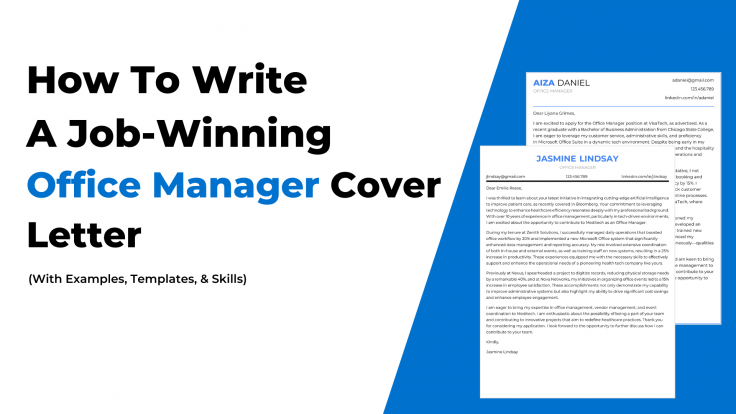
- LinkedIn 51
- Pinterest 0
Looking to score a job as an Office Manager?
You're going to need an awesome cover letter. This guide is your one-stop-shop for writing a job-winning Office Manager cover letter using our proven strategies, skills, templates, and examples.
All of the content in this guide is based on data from coaching thousands of job seekers (just like you!) who went on to land offers at the world's best companies.
If you want to maximize your chances of landing that Office Manager role, I recommend reading this piece from top to bottom. But if you're just looking for something specific, here's what's included in this guide:
- What To Know About Writing A Job-Winning Office Manager Cover Letter
- The Best Skills To Include On An Office Manager Cover Letter
- How To Address An Office Manager Cover Letter
- 3 Office Manager Cover Letter Examples
The 8 Best Office Manager Cover Letter Templates
3 tips for writing a job-winning office manager cover letter.
Here's the step-by-step breakdown:
Office Manager Cover Letter Overview: What To Know To Write A Cover Letter That Wins More Job Offers
What do companies look for when they're hiring an Office Manager?
Companies love candidates with strong organizational and multitasking abilities to manage office operations. They also look for individuals with outstanding communication and interpersonal skills to coordinate with staff and external partners.
Companies also appreciate candidates adept in office software and administrative tools for scheduling and data management tasks. Lastly, a proactive approach and problem-solving mindset are essential for addressing challenges and enhancing office processes.
Your cover letter should show the company that your personality and your experience encompass all of these things.
Additionally, there are a few best practices you want to follow to write a job-winning Office Manager cover letter:
- Properly address your letter: Begin your letter by addressing the hiring manager or team. Don't forget to state the specific Office Manager job you are interested in!
- Express your understanding of the company: Clearly articulate that you are well-familiarized with the company's products and the market, and tie this up with your skills, demonstrating how they align with their needs.
- Highlight your skills: Showcase your most relevant skills for the role, such as Management, Communication, Operations, and more.
- Tailor your cover letter for the job description: Emphasize your experience to meet the job requirements listed in the description.
- Be concise and clear: Your cover letter should be short and easy to read. Keep it to one page and focus on the good stuff!
- End with a call to action: Close with an effective call to action, expressing enthusiasm for the opportunity and inviting further discussion on how you can contribute to the company's success.
- Proofread: Make sure to thoroughly proofread your cover letter for any grammatical errors or typos. A well-written, error-free letter can make a strong first impression. I recommend using Hemingway App or Grammarly to do this.
Let's dive deeper into each of these, so you have the exact blueprint you need to see success.
The Best Office Manager Skills To Include On Your Cover Letter
Keywords are one of the most important factors in your cover letter. They show employers that your skills align with the role, and they also help format your cover letter for Applicant Tracking Systems (ATS).
If you're not familiar with ATS systems, they are pieces of software used by employers to manage job applications. They scan cover letters for keywords and qualifications and make it easier for employers to filter and search for candidates whose qualifications match the role.
If you want to win more interviews and job offers, you need to have a keyword-optimized cover letter. There are two ways to find the right keywords:
1. Leverage The 20 Best Office Manager Keywords
The first is to leverage our list of the best keywords and skills for an Office Manager cover letter.
These keywords were selected from an analysis of real Office Manager job descriptions sourced from actual job boards. Here they are:
- Communication
- Administrative Support
- Coordination
- Point Of Contact
- Interpersonal
- Professionalism
2. Use ResyMatch.io To Find The Best Keywords That Are Specific To Your Cover Letter And Target Role
The second method is the one I recommend because it's personalized to your specific cover letter and target job.
This process lets you find the exact keywords that your cover letter is missing when compared to the individual role you're applying for.
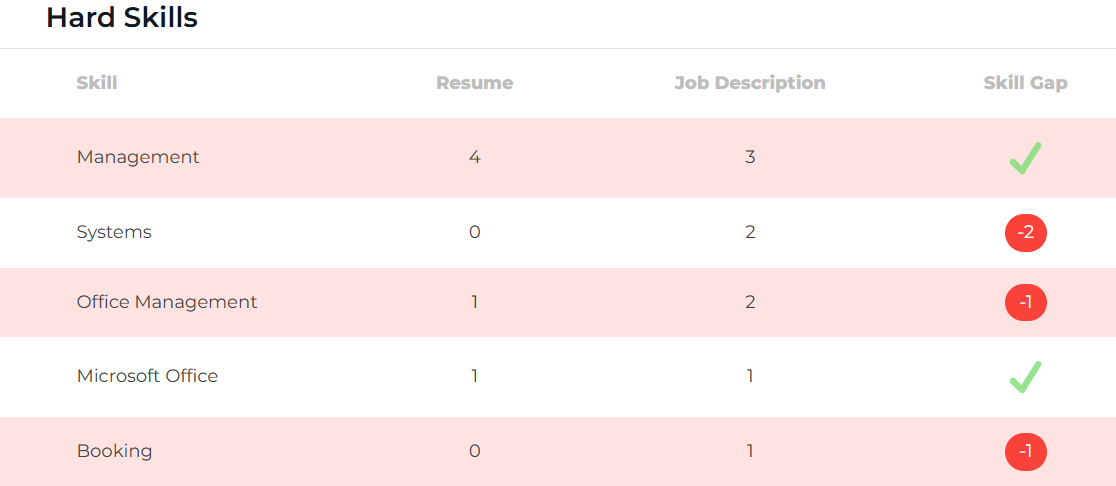
Here's how it works:
- Open a copy of your updated Office Manager cover letter
- Open a copy of your target Office Manager job description
- In the widget below, paste the job description and hit scan!
ResyMatch is going to scan the target job description and show you the exact keywords and skills that are relevant to the role and that you should weave into your cover letter.
If you're ready to check it out, grab your target job description and run your first scan here:
To start, paste your target job description (or multiple job descriptions) into the box below:
Scan to help you identify keywords and skills within your target job description.
Scanning...
If you're more of a visual learner, here's a video walking through this whole process so you can follow along:
How To Address A Office Manager Cover Letter
Personalization is what makes a cover letter stand out. That starts from the very first sentence where you greet the person reading your cover letter! There are two ways to do this well:
1. Use The Hiring Manager's Name
The first, and best, is by including the hiring manager's name. Let's say that you discovered the hiring manager's name from a post on LinkedIn or via an informational interview.
This is the jackpot! All you need to do is use their name in the introduction, like this:

2. Use This Formula: To The [Department] Team at [Company]
If you don't have the hiring manager's name, no problem! You can address your cover letter to the team that you're applying to.
For example, if you're applying for a Product Marketing Manager role at Discovery Education, you might start your cover letter like this:
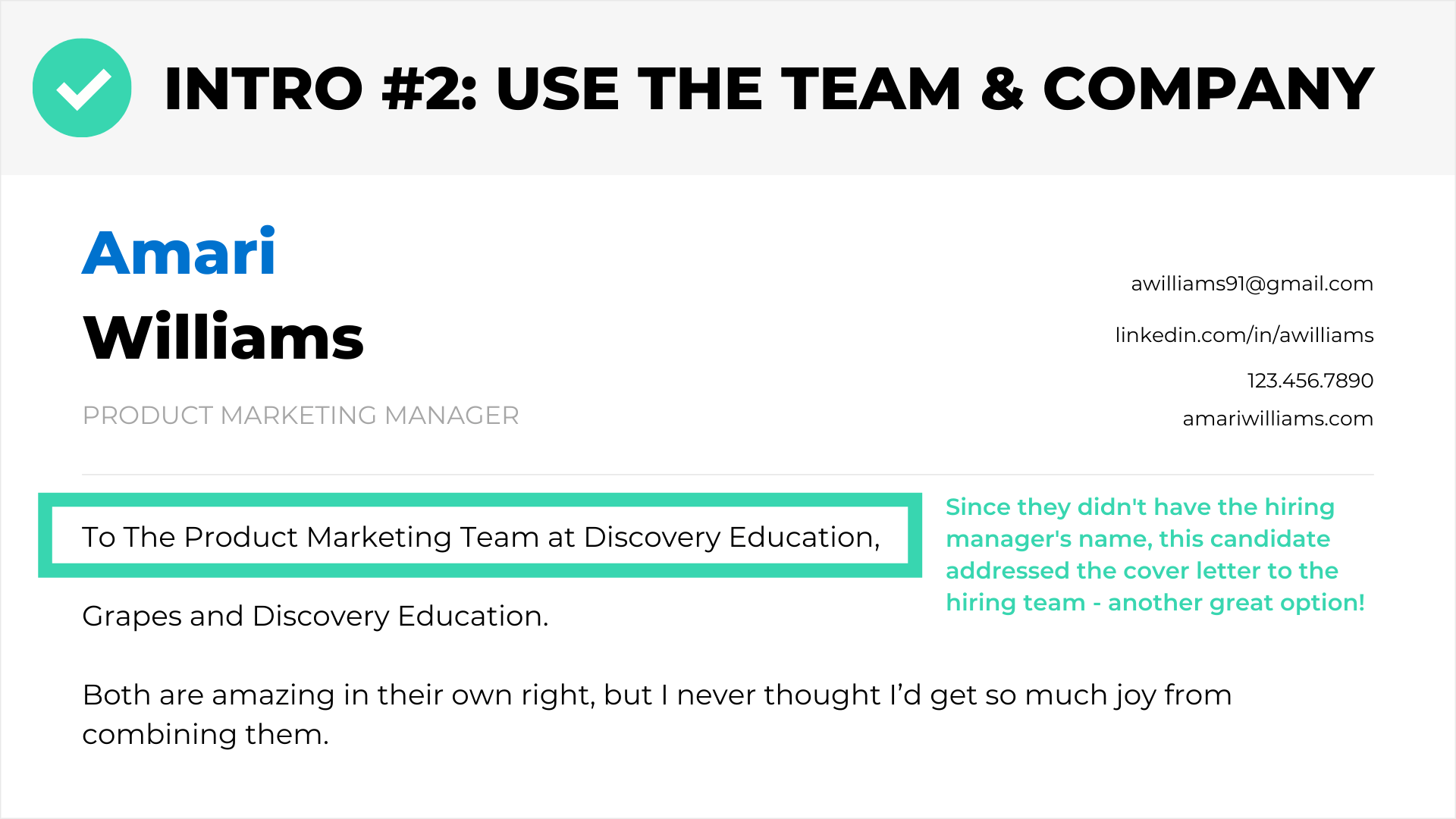
This shows the reader that this letter has been written specifically for them and the content inside of it will support that.
It's much more relevant and personal than “To Whom It May Concern!”
For more advice on writing a strong opening to your cover letter, check out this guide.
3 Office Manager Cover Letter Examples For 2024
Now let's take a look at all of these best practices in action. Here are three cover letter examples for different situations from people with different backgrounds who are all applying for Office Manager roles:
Office Manager Cover Letter Example #1: A Traditional Background
Our first example is a cover letter written by a candidate with traditional experience. Here is what an example of their cover letter might look like:

Office Manager Cover Letter Example #2: A Non-Traditional Background
Our second cover letter example comes from a candidate looking to transition from a background in education to an Office Manager role. This cover letter demonstrates how the author identifies and communicates their transferable skills:
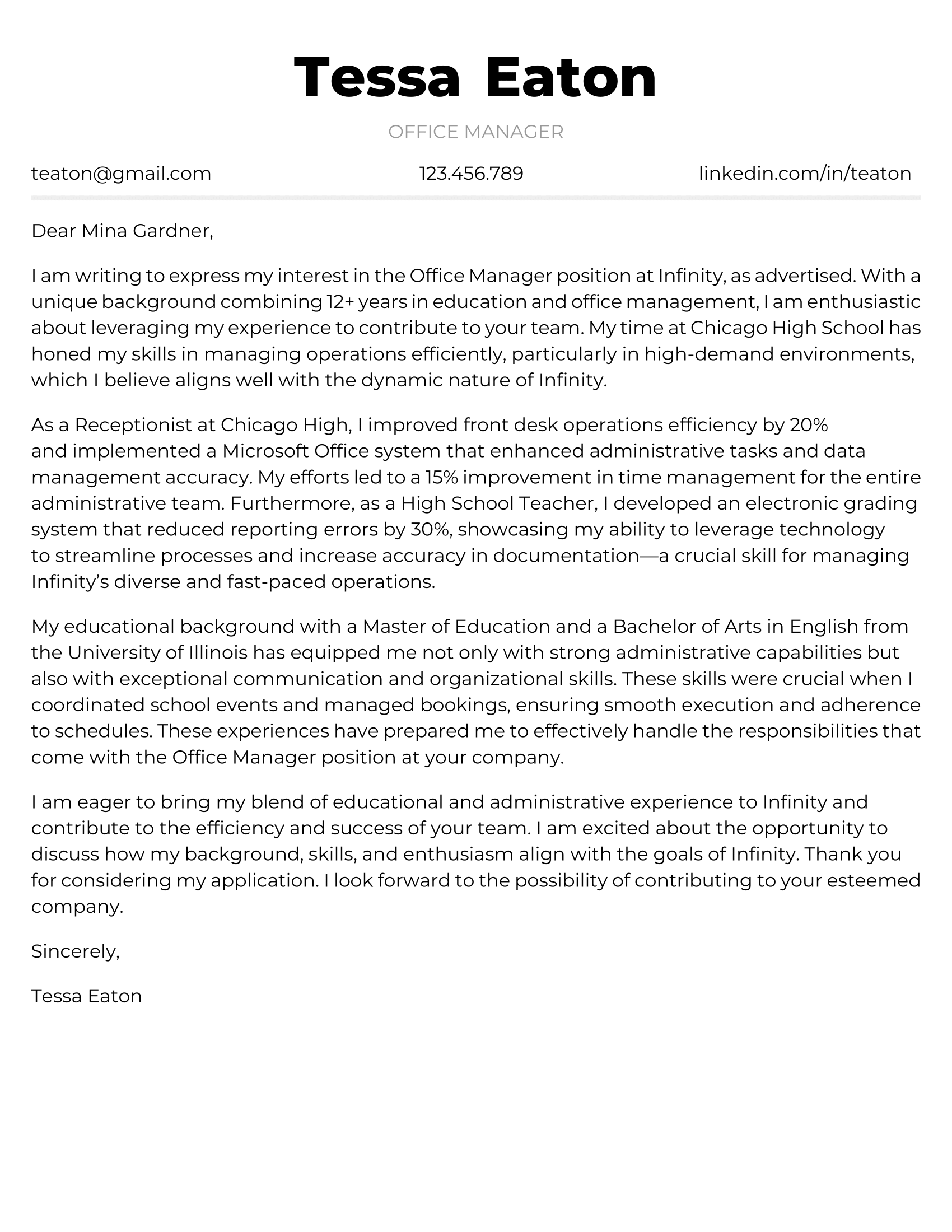
Office Manager Cover Letter Example #3: No Experience
Our third example highlights an Office Manager with no experience. Here is what their cover letter might look like:
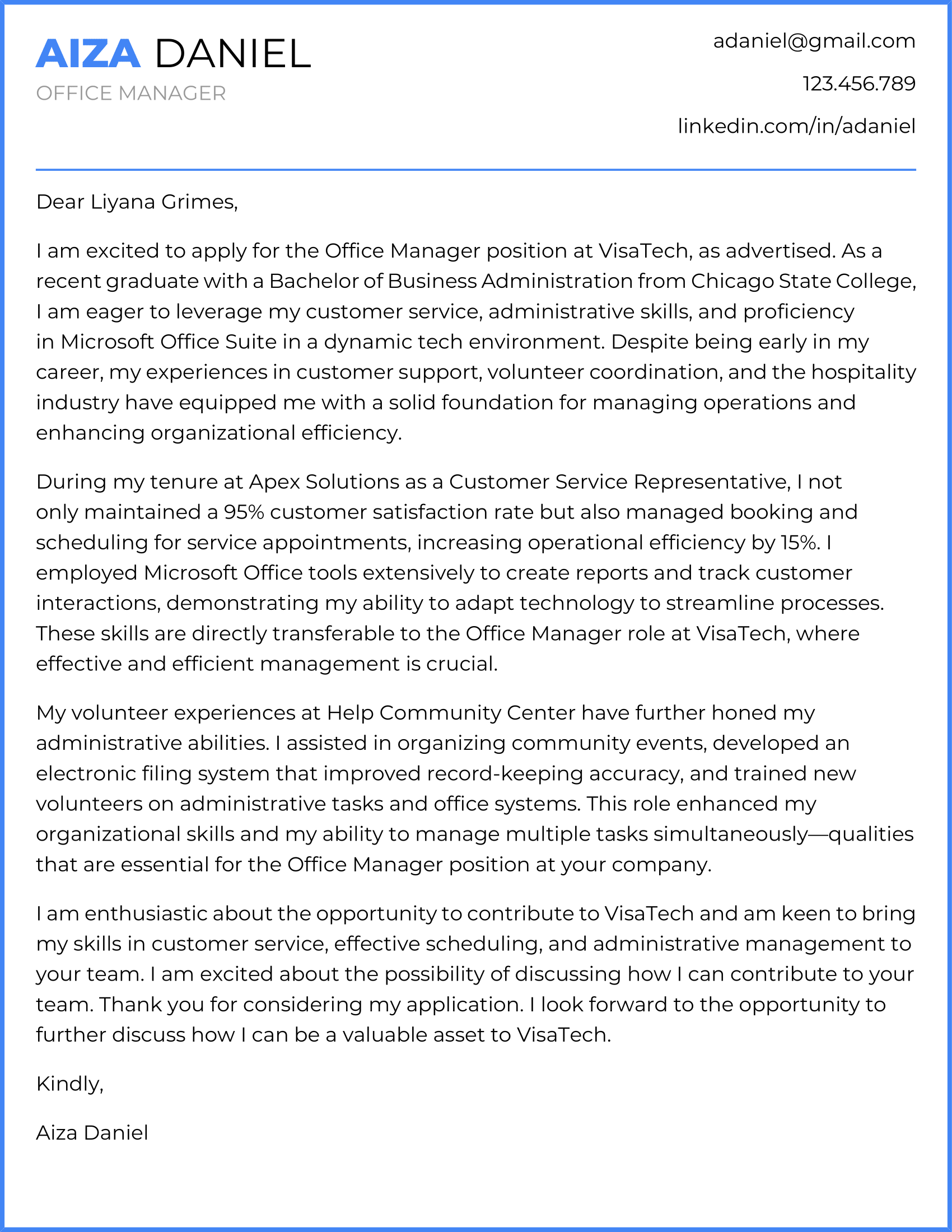
At this point, you know all of the basics you'll need to write an Office Manager cover letter that wins you more interviews and offers. The only thing left is to take all of that information and apply it to a template that's going to help you get results.
We made that easy with our CoverBuild tool . It has 8 proven templates that were created with the help of recruiters and hiring managers at the world's best companies. These templates also bake in thousands of data points we have from the job seekers in our audience who have used them to land job offers.
Just click any of the templates below to start building your cover letter using proven, recruiter-approved templates:

Free Job-Winning Cover Letter Templates, Have AI Write Yours in Less Than 2 Minutes .
Choose a cover letter template below to get started:.
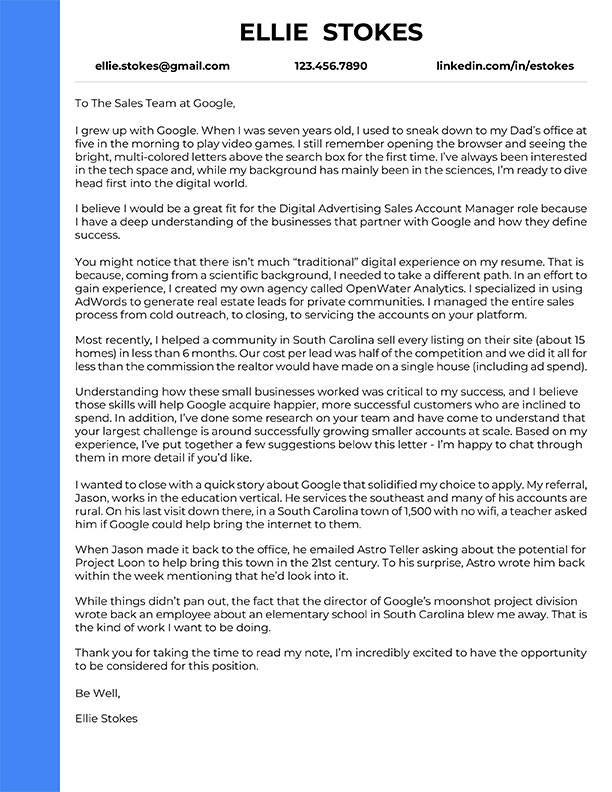
Great Choice! Now, how do you want to write your cover letter?
Let AI write your unique cover letter using our proven templates.
Or use our templates to write your own from scratch.
You're off to a strong start! But I've got a few more tips to help you take your cover letter to the next level:
1. Use CoverBuild.io To Write Your Cover Letter In <2 Minutes
All of these tips and best practices work, but you still have to implement them. Normally, that'd mean you sitting down and spending hours brainstorming ideas, typing, deleting, and typing again, and then feeling absolutely drained.
Now there's a way to work around all of that so you save your best energy for the writing and edits that matter most. Here's how it works:
- Head to CoverBuild.io
- Select the “2 Minutes” option to have AI write your cover letter
- Select a template for your cover letter, then follow the 3 step process for sharing info about your experience and the target job with CoverBuild's AI
- Click “Generate My Cover Letter” and watch the tool write a unique cover letter that's personalized to your experience and your target job!
To make it even easier, you can select a cover letter template from the widget below to get started:
If you'd like to see the process in action, here's a video walking through all of the steps above:
Note: I do not recommend or advise that you simply copy and paste any AI-generated content and submit your application. You should always review, revise, and personalize the content yourself before applying.
2. Include Measurable Metrics And Outcomes
Too many job seekers only focus on the actions that they took and not the outcomes that resulted from those actions. As a hiring manager, it's impossible to differentiate between a dozen candidates who were all “Responsible for managing calendar and communication.”
If you want to win, your cover letter should speak to the specific outcomes that you drove in previous roles. That could be:
- The office workflow you helped improve
- The increase in productivity you helped achieve
- The costs you helped reduce
These outcomes will show hiring teams what you're capable of and make your value crystal clear!
3. Match Your Cover Letter And Resume Design

They're the exact same car, down to the year, make, and model. The only difference is the way the product was presented. Like I said, quality impacts perceived value.
One of the best ways to boost the quality of your cover letter is to make it look clean, professional, and have it match your resume. That's why the resume templates in our resume builder tool match the cover letter templates in our cover letter builder:
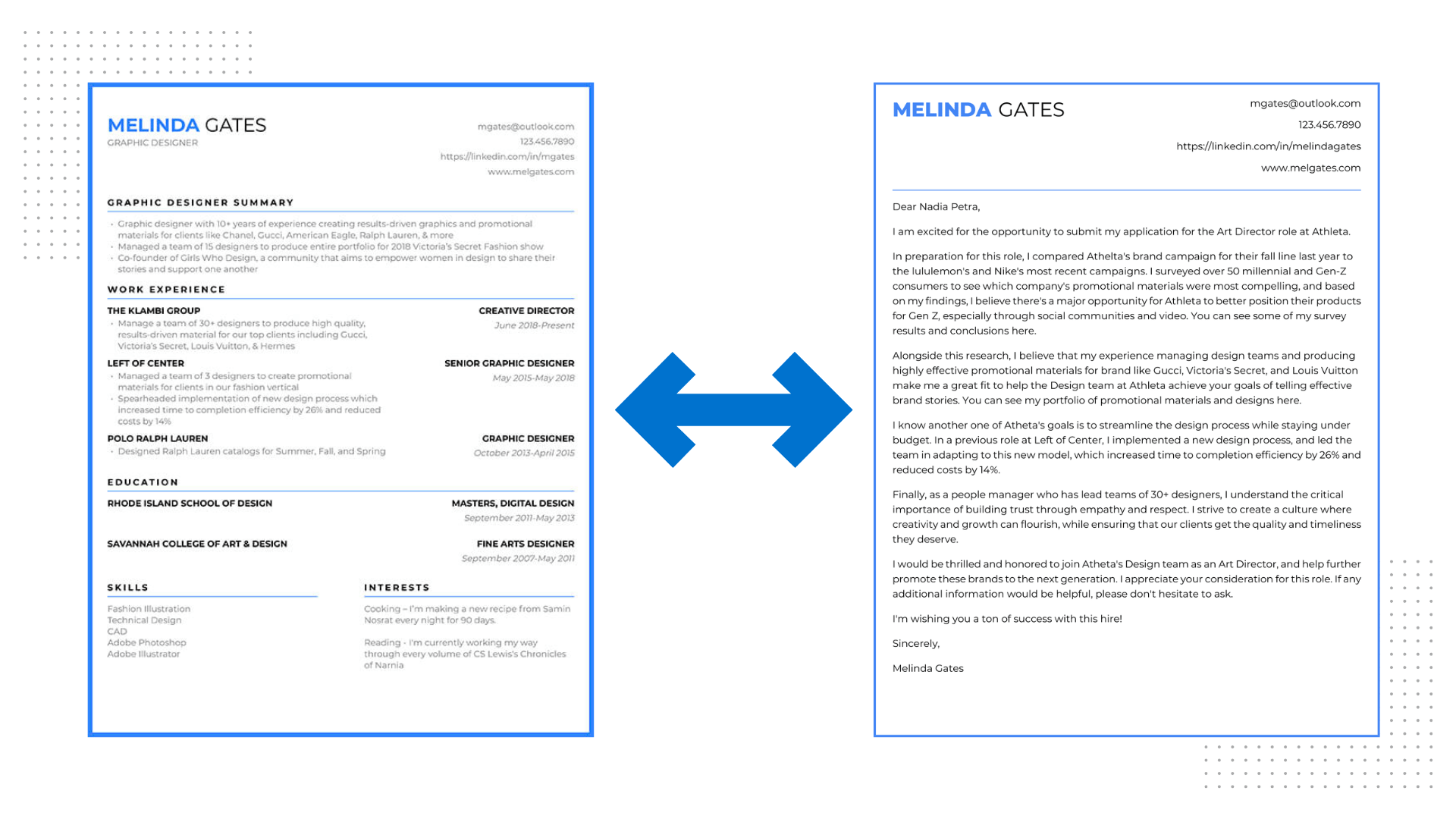
If you use both tools to create your cover letter and your resume, your entire application is going to be top notch.
Key Takeaways To Wrap Up Your Job-Winning Cover Letter
You made it! We packed a lot of information into this post so I wanted to distill the key points for you and lay out next steps so you know exactly where to from here.
Here are the 5 steps for writing a job-winning Office Manager cover letter:
- Start with a proven cover letter template from CoverBuild.io
- Use ResyMatch.io to find the right keywords and optimize your cover letter for each role you apply to
- Start your cover letter with a personalized greeting for the hiring manager or team name
- Emphasize the measurable outcomes and value you drove in previous roles (include metrics!)
- Compare the draft of your cover letter to the examples on this page to make sure you're on the right path
- Use a tool like Hemingway App or Grammarly to proofread your cover letter before you submit it
If you follow those steps, you're going to be well on your way to landing more Office Manager interviews and job offers.
Now that your cover letter is taken care of, be sure to check out our guide on writing a job-winning Office Manager resume (with examples!).

Paula Martins
Paula is Cultivated Culture's amazing Editor and Content Manager. Her background is in journalism and she's transitioned from roles in education, to tech, to finance, and more. She blends her journalism background with her job search experience to share advice aimed at helping people like you land jobs they love without applying online.
LEAVE A REPLY Cancel reply
You must be logged in to post a comment.
Most Popular Posts

YOU’VE SEEN AUSTIN IN

WHAT CAN I HELP WITH?

Welcome Back To Cultivated Culture!
Log into your Cultivated Culture account using one of the options below:
You have exceeded the maximum number of phone messages in a 24 hour period. We limit the number of times you can request security codes in order to protect your security. Please try again later or /contact">contact us for assistance with accessing your account.
Forgot your password? Click here to reset.
Need a free acount? Click Here To Sign Up
By logging in, you agree to Cultivated Culture's Terms of Use , Privacy Policy , and agree to receive email updates.
One Free Account, Four Job-Winning Tools
Sign up for a free Cultivated Culture account and get access to all of our job search tools:
Your Bullet Score is:
Sign up for a free Cultivated Culture account to get the full breakdown of your bullet along with suggestions for improving it:
Sign Up To Save & Export Your Resume
Sign up to create, save, and export your resume and get access to our suite of job search tools!
Sign Up To Get More Free Email Searches
Create a free account to unlock more email searches and get access to all four of our job-winning tools:
Your Headline Score is:
Sign up for a free Cultivated Culture account to get the full breakdown of your headline along with suggestions for improving it:
Already have an acount? Click Here To Log In
We Just Need You To Verify Your Email.
We just emailed you a 6-digit code. Please check your email and enter it below.
Note: Your progress will not be saved until your email is verified. Closing this pop up or window might cause you to lose your progress.
Invalid Code
Choose one of the options below to get the verification code we sent you!
We'll need you to verify your email address before you're able to unlock free scans.
We'll need you to verify your email address before you're able to unlock free templates, saves, and exports.
We'll need you to verify your email address before you're able to unlock free email searches.
We sent a verification code to your email, all you have to do is paste that code here and submit to get full access!
Looks Like You Still Need To Verify Your Email Address!
Whoops! Looks like you still haven't verified your email address. We'll need you to do that before granting free, unlimited access to our tools.
If you can't find the original verification email, click the link below and we'll send a new one:
Sent! Please check your email.
Oops you've hit your credit limit..
Looks like you've used all 10 of your free credits for the month. Your credit limit will refresh in days. You can learn more about your credit limit here.
Want to stop worrying about credits?
Sign up for our Unlimited plan to get instance unlimited access to all of our jon search tools for one low price. Click below to learn more:
Go Unlimited!
Change plan.
Upgrade your plan to get unlimited access to all 5 of our offer-winning job search tools and 200 email searches / week:
Go Unlimited (& Save 10%)!
Upgrade to get unlimited access to our resume tools, 200 email searches / week, and 10% off our regular pricing thanks to your friend :
Your Unlimited plan comes with...
Unlimited access to all 5 of our resume tools
200 Mailscoop searches per week
No obligations - cancel any time
By clicking "Upgrade My Plan," you agree to Cultivated Culture's Terms of Service and Privacy Policy
By clicking "Change Plan," you agree to Cultivated Culture's Terms of Service and Privacy Policy
Confirm Your Plan Change
Here is a summary of your plan change:
Current Plan:
Please note the following for plan changes:
Your new plan and rebill date will be effective immediately
The number above depict retail plan pricing, any adjustments or credits will be available in the Invoices section of your Billing tab
If you're moving to a lower cost plan, the difference will be credited to your account and applied towards your next payment
By clicking "Confirm Plan Change," you agree to Cultivated Culture's Terms of Service and Privacy Policy
Unlimited Plan Upgrade
Change payment method.
Promo code has been applied to your purchase!
Note: This is a monthly subscription, your card will be automatically charged every month until you cancel your plan.
Terms of Use | Privacy Policy
(C) 2024 Cultivated Culture
Note: You will not be charged for updating your credit card using this form. After your new card is added, you will be billed on the date of your next billing cycle.
Upgrade Complete!
You are officially a
Unlimited Member
Invoice Details
Paid Today:
Start Date:
Subscription:
Next Bill Date (Est.):
Note: This receipt and future invoices will be available in the Billing Tab of your Account Dashboard .
Do You Want To Secure Your Account?
Increase your account security with one of our multi-factor authentication options:
Choose An Authentication Method
Awesome! Let's make your account more secure.
Choose your preferred authentication method:
Text Message Authentication
Enter the phone number that you want to use to set up text-based authentication for your account:
Text Message Verification Code Sent!
Please check your phone for verification code and enter below:
Email Verification Code Sent!
Please check your email for verification code and enter below:
No problem, we'll skip this for now. Do you want us to remind you to secure your account?
It's great to have you. We just have a few questions so we can personalize your experience with our tools:
- I haven't applied to any jobs yet and I am not sure where to start
- I know what types of jobs I am looking for and I have started applying or I plan to start soon
- I have been applying to jobs for 3 months or longer, but haven't gotten the results I'd hoped for
- Get a job in the same industry I currently work in
- Switch careers and get a job in a new industry
- Get promoted at my current company
- Improve my resume
- Improve my cover letter
- Enhance my LinkedIn presence
- Find jobs that I am compatible with
How to Address a Cover Letter When Applying for a Job
While addressing your cover letter may seem like a small part of your job application, your salutation may be the first thing an employer reads on your application. An appropriate opening can leave a good first impression and set the tone for a successful application that engages the interest of an employer. This article explains how to address a cover letter depending on the information available to you about the job you are applying for.
Who should you address a cover letter to?
While you may not be certain who will read your cover letter when applying for jobs, there are a few best practices for addressing a cover letter. Unless a job description includes information on a different person to send application materials to, you should address your cover letter to the hiring manager for the position. ‘Dear Hiring Manager’ is an appropriate greeting for situations when you don’t know the hiring manager’s name, but seeking out details about the team you would be working with shows that you have a strong interest in the company and pay attention to details.
Methods for finding the hiring manager’s name
The following methods can help you find the hiring manager’s name when applying for a new job:
Check the application materials
Sometimes a job posting or other application materials have the name and title of the person reviewing your application listed. Many companies include information about who to contact in order to streamline the job search process, so read the job listing carefully for any instruction on who to address your letter to. Look at email addresses or social media profiles linked to the posting and see if the hiring manager’s name is listed. If you previously communicated with someone at the company about your application, consider reaching out and asking who you should address your cover letter to.
Look at the company website
Some companies keep a list of key employees or even a full directory of their employees available on their website. They may have a separate careers page with information on a hiring manager, or you may be able to find the name of a human resources representative for your position. Look for who the managers are for the department are applying to work with and determine who would work most closely with your position. You can also search for the company online and find outside information on their hiring structure.
Call the business
You can call the front office of a company and ask for the name of the contact person for the position you are applying for. Be sure to call during business hours and be as specific as possible so that you get the name of the correct person. If you are still not able to confirm the name of a contact, the company will likely expect applicants to use the name of their hiring manager’s position or even leave off the greeting entirely.
How to address a cover letter
Use these steps as a guide toward addressing your cover letter:
1. First, verify your information
Once you have the name or title of the person receiving your cover letter, make sure that all of your information is accurate. Do a quick search to see if they have any honorifics such as Dr. or Prof. that you can include in your greeting Avoid using gendered language such as ‘Mr.’ or ‘Ms.’ unless you have confirmed that they prefer to be addressed by that term.
2. Second, choose a salutation
Including a salutation is optional and based on personal preference. One option for beginning your cover letter is to simply list the name of the hiring manager followed by a comma. ‘Dear’ followed by their name and a comma is also a professional way to open your greeting. You should avoid less casual greetings such as ‘hey’ and ‘hello.’
3. Third, use a consistent format
When addressing your cover letter, use the same font and style as the rest of your application materials. Your greeting should be above the body of your letter and below a header that includes your name and contact information. Use consistent spacing before and after the greeting to make the letter easier to read for the hiring manager while devoting most of the page to the content of your letter.
4. Lastly, proofread
Every time you send out a cover letter, proofread every part of it including the address. Proofreading can help you avoid accidentally sending one company a cover letter with another company’s hiring manager listed in the greeting. Confirm the spelling of any names or titles and have another person check your work for typos. You should also make sure that you are using proper capitalization for their name and title.
Template for how to address a cover letter
Here is a brief template you can use when crafting a new cover letter or adding to an existing one:
[First name] [Last name] [Address] [City, State ZIP code] [Email] [Phone number]
Dear [Honorific]. [First name] [Last name],
Examples of how to address a cover letter
These are all examples of an acceptable greeting for a cover letter:
- Dear Hiring Manager,
- Dr. Alison Choudary,
- Dear Human Resources Manager,
- Dear Revolve Marketing Team,
- Dear Prof. Rivera,
- Dear Sierra,
- Ms. Cleo Thet,
Regardless of whether you can find the name of the hiring manager or not, you can still include a professional greeting when addressing your cover letter. While the way you address your cover letter will not likely convince someone to hire you, a greeting with dated or unprofessional language can easily discourage a hiring manager from taking your application seriously. You can use only a first name or add a salutation and honorific depending on your preference.
Tips for addressing a cover letter
Use these tips to make sure your greeting is relevant and appropriate to the position:
- Avoid phrases like ‘to whom it may concern’ or any other excessively formal language when possible.
- Consider addressing the team you will be working with as a group if you do not have the name of your contact for the job.
- If you have already communicated with the hiring manager, look at their email signature to see how they prefer to be addressed. For example, if the hiring manager signs their emails as ‘Mr. Dunlap,’ that is an indication that you should call him that as opposed to his full name.
- When writing your cover letter or adapting it for a new position, make sure that every section including the greeting is professional and purposeful.
Get the Reddit app
Get help with your resume! Please read the Wiki before posting. Check out the COMMUNITY BOOKMARKS for helpful info.
When you don't know who you're writing a cover letter for... who do you address? Try this!
Cover letters seem to be a big issue with a lot of people writing job search documents. One of the more challenging parts I used to struggle with is... who the heck do you address your cover letter to if you don't know who is reading it? Is it HR? Is it the hiring manager?
In my opinion, "To whom it may concern" is too informal and lacks a lot of personality, plus it's ridiculously boring to read. "Dear HR at Company X " or "Dear Hiring manager" seems like it's targeting too specific of an audience if you want them both to read it... so who do you address it to?
Dear Company you're applying to
If I'm applying to Google, " Dear Google ". If I'm applying to Jack's Country BBQ, "Dear Jack's".
Using this approach addresses everyone that is reading your cover letter and it isn't boring. Furthermore, this approach also conveys a "family" or all-inclusive audience as if you are trying to be apart of it. The truth is, most companies love to promote a sense of team effort and addressing them as if they have that makes you stand out as someone who recognizes that. The HR departments of companies are also the ones who typically promote this sense of togetherness.
If you know exactly who is going to be reading your cover letter and/or resume, then it's good to address them by their name. However, if you don't know for sure, it's far better to use "Dear Company " because it allows you to stand out.
Feel free to share your thoughts below. Hopefully this helps some of you struggling with the dreaded cover letter....
Protect your data
This site uses cookies and related technologies for site operation, and analytics as described in our Privacy Policy . You may choose to consent to our use of these technologies, reject non-essential technologies, or further manage your preferences.
- Resume and Cover Letter
- How to Address a Cover Letter...
How to Address a Cover Letter to Recruiter or Hiring Manager
5 min read · Updated on November 24, 2021

Knowing how to effectively address a cover letter makes you a very visible and appealing candidate.
Did you know that the cardinal rule of cover letters is personalization? It impresses a hiring manager or recruiter because it tells them you took time to research the specific information for the letter rather than sending a generic version.
What many people forget, however, is that the greeting or salutation in a cover letter must also be personalized with the hiring professional's first and last name whenever possible.
There are several effective ways to find the hiring manager's name for your greeting — and some acceptable back-up strategies when you can't. Either way, knowing how to address a cover letter effectively can prevent you from ending your hiring chances before they even begin.
When you know the hiring manager's name
More often than not, you'll be given the name of the hiring professional or the manager that you'll work for. Whoever it is, use their full name (first and last name) in the greeting.
If you cannot definitively tell the gender of the hiring person, do not use a gender-based title such as “Mr.” or “Ms.” in the greeting. Instead just use the person's full name.
For example, Alex Johnson could be male or female. To avoid a gender mistake, use Dear Alex Johnson, Hello Alex Johnson, or simply Alex Johnson .
However, professional titles such as “Professor” or “Dr.” are definitely acceptable as a cover letter salutation and should be used as a sign of respect. Be on the lookout for these and other titles to include.
How to find a hiring manager's name for your cover letter
If you're not given the name of the hiring manager, here are some effective ways to discover their name by using:
The job description: Check this document for the hiring manager's name. While it's not generally listed, you never know. If it's not obvious, there's also a trick to quickly discover an email in the job description that might contain the name; while in the document, press Ctrl +F or run Command + F and search for the @ symbol.
An email address: If you discover an email address, it may not have a full name but rather a first initial and last name or just a first name like [email protected] or [email protected] . A Google search combining the person's name as shown in the email and the company name might find you the person's full name.
A LinkedIn post: A name connected to the LinkedIn job posting is probably that of the hiring professional who posted it, so use that name in your greeting.
The supervisor's title: It's more likely that a job description will list who the new hire will report to — such as the director of accounting — without listing a name. In this case, there are several search options:
Search the company's website for listings of staff members by title.
Run an advanced LinkedIn or Google search for all directors of accounting at that specific company.
Check with your network for someone who might know the person's name or search the appropriate professional networking sites.
Contact the company by phone or email. Tell them you're applying for [job title] and want to address your cover letter to the right person.
In the end, this research can be the difference between making a great first impression and getting noticed for the position — or getting totally ignored by the hiring manager.
Acceptable options in lieu of a name
If you try the steps above and come up empty, there are still some alternative greeting options that will put you in a professional light.
The idea is to show that you've read the job description and tailored your greeting based on the company department where the job is located, the hiring manager's title, or the team with which you'll potentially work.
Some good examples include:
Dear Head of Design
Hello IT Department
Dear Accounting Manager
To Company ABC Recruiter/Hiring Professional
Hello Marketing Hiring Team
Dear Customer Support Hiring Group
Dear Human Resources
If you still can't find any specific name or department information, go with “Dear Hiring Manager.” It sounds professional and it's not gender-specific. In fact, a recent survey of over 2000 companies by Saddleback College showed that 40 percent preferred “Dear Hiring Manager” as the best greeting when a manager's name can't be found.
“Dear Sir or Madam” is another option that works because it's gender-neutral and respectful. However, it sounds a bit old-fashioned and may signal a hiring professional that you're an older worker or just not aware of other greeting options. It's perfectly acceptable, but the better choice is “Dear Hiring Manager.”
In the end, an actual name or any of the alternative examples will let you stand out from the crowd, so do your best to find and use those whenever you can.
Never leave the greeting blank
Whatever information you may or may not find, it's important to never leave your greeting line blank.
A blank greeting line can make you come across as lazy or rude, or imply that you simply don't understand how to write a cover letter — all of which will immediately put you out of contention for the job. There's no reason to leave the greeting blank when there are so many options that can be used effectively.
When you spend the time and effort to personalize your cover letter, you don't want to come across as “just another candidate” by using a generic greeting or no greeting at all.
A personalized greeting will impress any hiring professional, increasing the chance they'll read your entire cover letter — and ask you for an interview.
Not sure if your cover letter is cutting it? Our writers don't just help you with your resume .
Recommended Reading:
Do Hiring Managers Actually Read Cover Letters?
5 Things to Say in Your Cover Letter If You Want to Get the Job
How To Write a Cover Letter (With Example)
Related Articles:
How to Create a Resume With No Education
From Bland to Beautiful: How We Made This Professional's Resume Shine
See how your CV stacks up.
Share this article:
Ready to rewrite your CV?
Want a free CV analysis?

IMAGES
VIDEO
COMMENTS
Rule #1: Address your cover letter to the hiring manager using a formal, full-name salutation (if possible). For a cover letter, you should always default to addressing it to the hiring manager for the position you're applying to. Unless you know for sure that the culture of the company is more casual, use the hiring manager's first and ...
Follow the title with their last name. For example: Dear Ms. Greene. Dear Mr. Johnson. Since your cover letter is likely going to be the first thing a recruiter or hiring manager sees, it's important to use good judgment in choosing a salutation. — Mary Morgan, SHRM-CP.
Whoever it is, use their full name (first and last name) in the greeting. If you cannot definitively tell the gender of the hiring person, do not use a gender-based title such as "Mr." or "Ms." in the greeting. Instead just use the person's full name. For example, Alex Johnson could be male or female. To avoid a gender mistake, use Dear ...
Here are the most common ways to address a cover letter without a name: To Whom It May Concern. Dear Human Resources Director. Dear Hiring Manager. Dear Recruitment Manager. Additionally, if you want to add a personal touch, address your cover letter to your prospective department or manager.
Dear Hiring Manager, But job seekers can often be more specific. Take a look at these examples: Dear Customer Experience Manager, Dear Customer Experience Hiring Team Manager, Some other alternatives include addressing your cover letter to an entire department: Dear Engineering Department, Dear Engineering Team,
2 Use a formal salutation. Unless you are applying for a very casual or creative position, you should use a formal salutation to address the hiring manager. Avoid using casual or informal ...
How to Address an Email Cover Letter . Hiring managers get a lot of emails each day. Make it easy for them to scan your email and follow up by including a clear subject line and a signature with your contact information. ... It's important to address the email cover letter correctly, including the name of the person hiring for the position if ...
1. Choose the right salutation. We are well past the days when "To Whom It May Concern" or "Dear Sir or Madam" were considered gold standard business salutations. Unless you're hoping to look like a nonagenarian on paper, plan to address your cover letter directly to the hiring manager or recruiter involved with the search.
For example, 'Dear Austen Myers' is acceptable and considered a professional way to address a cover letter. If you know their gender and wish to use a title in the address, use either 'Ms.' or 'Mr.' to avoid inaccurately describing the recipient's marital status. For example, you'd write 'Dear Ms. Myers' rather than 'Dear ...
How to address a cover letter without a name: Use Dear [XYZ] Hiring Manager. Example: Dear Sales Team Hiring Manager. Avoid obvious mistakes. Check spelling, gender, and titles. Use Ms. instead of Miss or Mrs. When emailing cover letters and resumes, write a subject line with "Application for" + job title.
In the body. The first line of your email should address the recipient, which differs slightly from paper cover letters. In cover letters, you usually add a header that includes your name and contact information, the date, and the recipient's name and contact information. After addressing the recipient, you can add your full cover letter in the ...
In that case, you can address your cover letter to the department, faculty, or the company. Alternatively, if you don't have enough information either about the department or the team, you can opt for addressing the cover letter directly to the company's hiring staff, as follows: Dear [Company Name] Hiring Team.
When writing a cover letter, you should always try to address it with the hiring manager's name. However, if you can't find it, simply addressing it with "Dear Hiring Manager" will suffice. The best ways to address someone in a cover letter are: Dear Andrew Lopez, Dear Nancy Wong, Dear Hiring Manager, Dear Recruiter,
If the job description tells you to submit a cover letter in an e-mail, you can add your contact details at the end, after your name. 4. Address the hiring manager. After listing your contact information, it's time to address the cover letter to the hiring manager using their name if possible.
Address a Cover Letter with "Dear Hiring Manager". It's the easiest way to address a cover letter without a name. And actually, 40% of managers prefer "Dear Hiring Manager" to any other cover letter salutation. Plus, you can replace the Hiring Manager with a different business title, such as: RIGHT.
Adding titles when addressing a cover letter. It is acceptable to use a title and the recipient's surname when addressing a cover letter. You could write "Dear Mr Nelson" instead of "Dear Chris Nelson.". You might do this if you do not know your recipient's first name. Call females Ms, unless you know they prefer Miss or Mrs.
And if your cover letter does not have a subject line, it will not show in the hiring manager's list. Here is an example cover letter subject line : Subject line: Job Application for Video Editor Position, Ref: Hanna Moore. 2. Address the Cover Letter in the Correct Way.
While it's important to address the hiring manager directly in your cover letter, oftentimes a job ad won't mention a contact person, especially if it's advertised through a recruiter. Fortunately, you can often find out who the hiring manager or head of the department is with a quick internet search. If all else fails, use "Dear Hiring Manager."
Here's a guide on how to address a cover letter to a recruiter or hiring manager: Use a formal salutation: Begin your cover letter with a professional salutation. If you know the name of the ...
Office Manager Cover Letter Example #3: No Experience. Our third example highlights an Office Manager with no experience. Here is what their cover letter might look like: The 8 Best Office Manager Cover Letter Templates. At this point, you know all of the basics you'll need to write an Office Manager cover letter that wins you more interviews ...
2. Second, choose a salutation. Including a salutation is optional and based on personal preference. One option for beginning your cover letter is to simply list the name of the hiring manager followed by a comma. 'Dear' followed by their name and a comma is also a professional way to open your greeting. You should avoid less casual ...
Before writing the body paragraphs and the "Dear Company", I'm wondering about the beginning portion of the cover letter where I write my information and the information of the company I'm applying to. So this is my template for the beginning of my cover letter, Name Address Phone # Email Date Name of Employer Position Company Address
Properly addressing your cover letter is a straightforward process. If you follow these simple steps, you should be able to address your cover letter correctly: 1. Examine the job description to find out the name of the recruitment manager. The first thing you should do when addressing your cover letter is to refer to the job description.
Formally address the letter, as you would in a printed cover letter. The subject line and an email cover letter are important to notice amid the hundreds of emails a recruiter might receive. Include your name, the job title you're applying for, the reason for contact, and what is included in the documents you're sending.
Here's how to address your cover letter effectively. If you don't personalize the greeting or salutation in your cover letter for each job you apply to, you can kiss your chance of landing the interview goodbye. ... How to Address a Cover Letter to Recruiter or Hiring Manager. 5 min read · Updated on November 24, 2021.
If possible, address your cover letter to the hiring manager or project manager by name. This personal touch shows your attention to detail—and it's attention-grabbing. If the job post doesn't include a contact name, visit the company website or LinkedIn to try to find the right person.
Managers generally aren't hiring based solely on your work history; your experience is crucial, yes, but they're also looking for someone who will be easy to work with, shows good judgment ...